Going Right
April 29, 2016

Renewable Energy Persuasive Essay
Robert Caba
Dr. Freymiller
12 April 2016
Out with the Old, In with the Re(new)able
The United States has been operating as a country using limited fossil fuels, but what happens when it all runs out? Would it not be more beneficial to never find out? Renewable energy, energy that is not depleted after its use, is limitless and more sustainable than any other source in energy history. To initiate the clean energy movement is expensive, but there are countless benefits ranging from individual to global impacts in going completely renewable. The first recorded use of renewable energy was harnessing wind power to drive ships over water about 7000 years ago (Darling). However, renewable energy has been around as long as Earth has existed: wind, sun, geothermal, biomass and many more. Clean energy sources can be harnessed to produce electricity, process heat, fuel and other chemicals with significantly less impact on the environment. In 2014, renewable energy sources accounted for fourteen percent of America’s total electricity use (“Renewable Energy Sources”), a four percent incline from the prior year. Completely diverting from fossil fuels to renewable energy clearly is not a new concept for a select few of innovative countries. A few countries, for example, are Costa Rica, Norway and Iceland, all of whom have ran on renewable energy for the entire 2015 calendar year, diving deep into their own land’s resources and utilizing volcanic presence to produce energy (Rosecrance & Thompson 7). Following in the footsteps of Costa Rica and a few other third world countries, major economic powerhouses and biggest users of fossil fuels like the United States should convert to clean energy as a way to benefit the economy, environment and overall health of the country.
As a consumer, one is worried about how abandoning a safe form of energy and transitioning to something new can help or hurt their wallet. Not only can renewable energy help save money, it can also help make money. A 150 billion dollar investment into this new industry would result in 1.7 million job opportunities, reducing the unemployment rate in America by an entire percentage (Pollin & Heintz). The reason for the potential high employment rate is because the industry is labor intensive in the means of installation and maintenance, requiring a lot of manpower for ultimate success. However, the more we wait the more future benefits we are currently losing. In an American Solar Energy Association (ASES) report in 2009, they stated “the 2008 predictions for renewable energy industry in 2030 are significantly lower than the 2007 predictions (National Research Council 169).” Unlike fossil fuels, which are subject to volatile pricing fluctuating over time depending on the market, renewable energy is relatively “free” after installation, using natural resources. The process of transportation and maintenance is minimized allowing prices to stay constant throughout the years. The only way price can head is down; for instance, clean energy is more affordable than 25 years ago. In particular, wind energy, the fastest growing source of power, prices have declined from forty cents per kilowatt per hour to less than five cents per kilowatt per hour (“The Energy Story”), a remarkable change and a huge upside in favor of the conversion. As time continues, technology should continue its progression resulting in cheaper mediums to acquire the energy. Despite of this, the conversion should take place now so results are maximized for the future. All in all, clean energy can both save Americans money while help them make money, the perfect win-win for producers and consumers alike.
Abstaining from burning countless, yet limited fossil fuels every day and polluting the environment is the single biggest benefactor for moving towards a cleaner approach. Not only would greenhouse gas emissions, as well as other pollutants that cause smog and acid rain, reach minimal levels, but also the country is consequently assisting in the reduction of the global warming speed and effects. Unlike fossil fuels, which are unable to be replenished easily, renewable energy is limitless, feeding from natural resources. With the global and national population expected to continue rising, the demand for energy will follow. There is a multitude of different approaches to acquire renewable energy including the most used types: solar and wind power. Specifically, solar energy is the epitome of sustainability and efficiency, calculated through production and prices. Despite the massive amounts of energy used yearly nationwide, “the sunlight falling on the United States in one day contains more than twice the energy we consume in an entire year ( The Energy Story ).” As for wind power, “California [alone] has enough wind gusts to produce 11 percent of the world’s wind electricity ( The Energy Story).” Wind turbines take up a lot of space but still allow the area around it, usually farms, to be used regularly. In the United Kingdom, for comparison, the government set a target for renewable energy to make up 15 percent of their total energy expense by 2020. This motive results in a 34 percent cut in the country’s carbon emission in the same time span (National Research Council 180). Needless to say, renewable energy will make landmark strides in the progression towards a cleaner, better environment. The most important thing on this Earth is this Earth, and it’s society’s job to maintain it.
As well as helping the environment and wallets, renewable energy can help with everyone’s health. By cutting the emission of greenhouse gasses and fossil fuels, air pollution decreases. Air pollution, primarily those contributed through coal burning power plants emitting fine-particulate pollutants, is most associated with causing health problems, chiefly lung cancer. The Environment Protection Agency (EPA) predicts that conversion, or even standards, will prevent at least 100,000 heart attacks and asthma attacks per year. Additionally, EPA also estimates a projected 1,100 billion dollar income in health benefits due to avoiding illnesses and deaths (U.S. EPA). As a form of partnership, the health industry could invest a portion of this money into the clean air movement due to its beneficial health impacts and help make installation cheaper. A majority of these pollutants are associated with dangerous levels of climate change, this century’s biggest threat to human health. Climate change, a change in global climate patterns, “will increasingly jeopardize the fundamental requirements for health, including clean urban air, safe and sufficient drinking-water, a secure and nutritious food supply, and adequate shelter (World Health Organization).” Climate change is the main contributor and accelerator towards global warming. Global warming increases the risk of two deadly diseases: Plague and Ebola, to name a few. For Plague, changes in temperature and rainfall will affect rodent populations as well as the infected fleas they carry. Additionally, Ebola outbreaks tend to follow serious downpours or droughts, a likely result of climate change (Biello). The movement would not only lower the pollution rate and risk of infection, but also save countless lives across the globe during the process.
America, along with most other countries, needs to initiate their plans towards a more sustainable, cleaner form of energy. Renewable energy helps increase the production of the economy through the addition of million of jobs. Simultaneously, energy prices would be lower, also helping the consumer save money. However, it is vital to start now. The longer the wait, the less benefits are reaped. Likewise, the clean air movement will mark the beginning of recovery for the environment. Greenhouse gases and other emission will reach all time lows, possibly zero. This deduction is important to slow the rate of climate change and global warming. Stopping climate change and gas emissions in its tracks would also lead to more health benefits. There are dozens of deadly diseases and carriers that spawn from the irregular climate patterns. Also, climate change could affect physiological needs by lessening safe drinking water, food supply and shelter. The United States has a reputation of being an innovator, a leader for many countries. Why has it been so lackadaisical with something so important to everything in today’s society? It has a history of being scared of change; people are too comfortable with life as it is, but it could be better. With the United States recently moving in the right direction, it will be better.
Works Cited
Biello, David. “Diseases Due to Climate Change.” Scientific American . N.p., 8 Oct. 2008. Web. 9 Apr. 2016.
Darling, David. “Wind Energy.” Encyclopedia of Alternative Energy . N.p., n.d. Web. 11 Apr. 2016.
National Research Council, and Chinese Academy of Sciences. The Power of Renewables: Opportunities and Challenges for China and the United States . Washington, D.C.: National Academies, 2010. Print.
Pollin, Robert, and James Heintz. “The Economic Benefits of Investing in Clean Energy.” Center for American Progress . N.p., 18 June 2009. Web. 06 Apr. 2016.
“Renewable Energy Sources – Energy Explained, Your Guide To Understanding Energy – Energy Information Administration.” EIA . US Energy Information Administration, 17 Mar. 2015. Web. 11 Apr. 2016.
Rosecrance, Richard, and Peter Thompson. “Global Trends in Sustainable Energy Investment.” Annual Review of Political Science 6.1 (2003): 7. UNEP . United Nations Environment Programme, 13 Oct. 2014. Web. 10 Apr. 2016.
“The Energy Story – Chapter 17: Renewable Energy vs. Fossil Fuels.” The Energy Story . California Energy Commission, n.d. Web. 11 Apr. 2016.
U.S. EPA. “Cleaning Up Toxic Air Pollution.” Benefits and Costs of Cleaning up Toxic Air Pollution (n.d.): n. pag. EPA . Environment Protection Agency. Web. 10 Apr. 2016.
World Health Organization. Renewable Energy (n.d.): 7. WHO . World Health Organization, 2012. Web. 10 Apr. 2016.
Leave a Reply
You must be logged in to post a comment.
Numbers, Facts and Trends Shaping Your World
Read our research on:
Full Topic List
Regions & Countries
- Publications
- Our Methods
- Short Reads
- Tools & Resources
Read Our Research On:
2. Public opinion on renewables and other energy sources
Americans’ concerns about climate change have put energy production of fossil fuels and the carbon gases these fuels emit at the center of public discussions about climate and the environment. Those debates coupled with long-standing economic pressures to decrease reliance on other countries for energy needs have raised attention to renewable forms of energy including solar and wind power.
Public opinion about energy issues is widely supportive of expanding both solar and wind power but more closely divided when it comes to expanding fossil fuel energies such as coal mining, offshore oil and gas drilling, and hydraulic fracturing for oil and natural gas. While there are substantial party and ideological divides over increasing fossil fuel and nuclear energy sources, strong majorities of all party and ideology groups support more solar and wind production.
Most Americans know the U.S. is producing more energy today
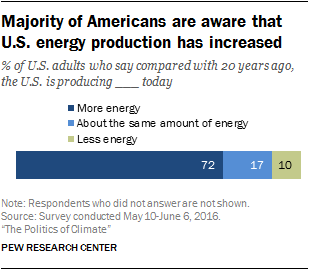
Most Americans are aware of America’s ongoing energy boom . The United States is producing more energy from fossil fuels and has ticked up production of renewable sources such as wind and solar. A large majority of Americans (72%) say the United States is producing more energy than it did 20 years ago. Far smaller shares say the U.S. is producing the same level (17%) or less energy (10%) than it did 20 years ago 8
Majorities across demographic, educational and political groups say the U.S. is producing more energy today. Awareness of this trend is especially high among those with postgraduate degrees (86% compared with 64% among those with high school degrees or less). Men are more inclined to say the U.S. is producing more energy than women (79% vs. 66%), while Democrats are modestly more likely than Republicans to say this (79% vs. 65%).
Strong public support for more wind and solar, closer divides over nuclear and fossil fuels
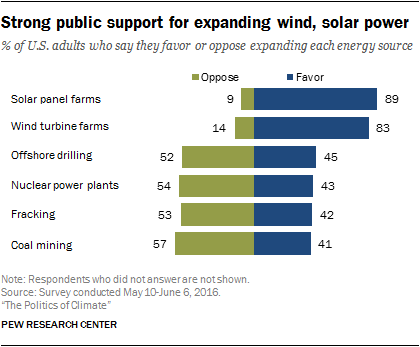
Large majorities of Americans favor expanding renewable sources to provide energy, but the public is far less supportive of increasing the production of fossil fuels, such as oil and gas, and nuclear energy.
Fully 89% of Americans favor more solar panel farms, just 9% oppose. A similarly large share supports more wind turbine farms (83% favor, 14% oppose).
By comparison, the public is more divided over expanding the production of nuclear and fossil fuel energy sources. Specifically, 45% favor more offshore oil and gas drilling, while 52% oppose. Similar shares support and oppose expanding hydraulic fracturing or “fracking” for oil and gas (42% favor and 53% oppose). Some 41% favor more coal mining, while a 57% majority opposes this.
And, 43% of Americans support building more nuclear power plants, while 54% oppose. Past Pew Research Center surveys on energy issues, using somewhat different question wording and survey methodology, found opinion broadly in keeping with this new survey. For example, the balance of opinion in a 2014 Pew Research Center survey about building more nuclear power plants was similar (45% favor, 51% oppose), and some 52% of Americans favored and 44% opposed allowing more offshore oil and gas drilling in that survey.
Most Republicans and Democrats favor expanding renewables; there are strong divides over expanding fossil fuels
Across the political spectrum, large majorities support expansion of solar panel and wind turbine farms. Some 83% of conservative Republicans favor more solar panel farms; so, too, do virtually all liberal Democrats (97%). Similarly, there is widespread agreement across party and ideological groups in favor of expanding wind energy.
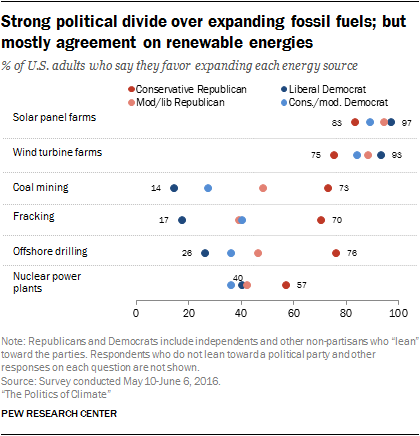
Consistent with past Pew Research Center surveys , this new survey finds there are deep political divides over expanding fossil fuel energy sources. Conservative Republicans stand out from other party and ideology groups in this regard. At least seven-in-ten conservative Republicans support more coal mining (73%), fracking (70%) and offshore drilling (76%). A majority of Democrats oppose expanding each of these energy sources while moderate/liberal Republicans fall somewhere in the middle on these issues.
The political divide over expanding nuclear energy is smaller. Some 57% of conservative Republicans, and 51% of all Republicans, favor more nuclear power plants. Democrats lean in the opposite direction with 59% opposed and 38% in favor of more nuclear power plants.
As also found in past Pew Research Center surveys , women are less supportive of expanding nuclear power than men, even after controlling for politics and education. Some 34% of women favor and 62% oppose more nuclear plants. Men are more closely divided on this issue: 52% favor and 46% oppose. Men and women hold more similar views on other energy issues.
Many Americans are giving serious thought to having solar panels at home
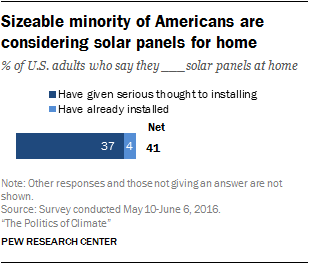
America’s solar power industry is growing. In 2016, solar is expected to add more electricity generating capacity than any other energy source in the United States. Just 4% of Americans report having home solar panels but many more − 37% − say they are giving it serious thought.
These figures are similar among homeowners. Some 44% of homeowners have already installed (4%) or have given serious thought to installing (40%) solar panels at home.
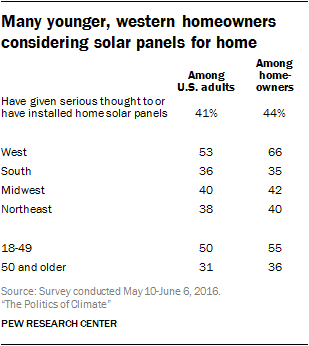
Western residents and younger adults are especially likely to say are considering, or have installed, solar panels at home. Some 14% of homeowners in the West have installed solar panels at home and another 52% say they are considering doing so. By contrast, 35% of homeowners in the South say they have installed (3%) or given serious thought to installing solar at home (33%).
Some 55% of homeowners under age 50 say they have given serious thought to installing or have already installed solar panels at home. Fewer homeowners ages 50 and older say the same (36%).
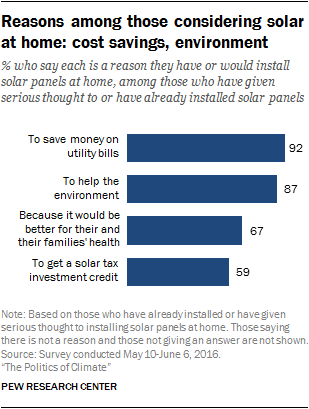
The key reasons people cite for considering solar are financial followed by concern for the environment. Among all who have installed or given serious thought to installing solar panels, large majorities say their reasons include cost savings on utilities (92%) or helping the environment (87%). Smaller shares of this group, though still majorities, say improved health (67%) or a solar tax investment credit (59%) are reasons they have or would install home solar panels.
- Pew Research Center in 2014 asked a related question – whether the amount of energy produced in the United States had been increasing, decreasing or staying the same in recent years. In that survey, 54% of Americans said the amount of energy produced had been increasing, while 27% said it had been staying the same and 10% said it had been decreasing. ↩
Sign up for The Briefing
Weekly updates on the world of news & information
Most Popular
1615 L St. NW, Suite 800 Washington, DC 20036 USA (+1) 202-419-4300 | Main (+1) 202-857-8562 | Fax (+1) 202-419-4372 | Media Inquiries
Research Topics
- Age & Generations
- Coronavirus (COVID-19)
- Economy & Work
- Family & Relationships
- Gender & LGBTQ
- Immigration & Migration
- International Affairs
- Internet & Technology
- Methodological Research
- News Habits & Media
- Non-U.S. Governments
- Other Topics
- Politics & Policy
- Race & Ethnicity
- Email Newsletters
ABOUT PEW RESEARCH CENTER Pew Research Center is a nonpartisan fact tank that informs the public about the issues, attitudes and trends shaping the world. It conducts public opinion polling, demographic research, media content analysis and other empirical social science research. Pew Research Center does not take policy positions. It is a subsidiary of The Pew Charitable Trusts .
Copyright 2024 Pew Research Center
Terms & Conditions
Privacy Policy
Cookie Settings
Reprints, Permissions & Use Policy
Renewable Energy Explained
Solar, wind, hydroelectric, biomass, and geothermal power can provide energy without the planet-warming effects of fossil fuels.
Chemistry, Conservation, Earth Science, Engineering
Braes of Doune Wind Farm
As of 2017, wind turbines, like the Braes of Doune wind farm near Stirling, Scotland, are now producing 539,000 megawatts of power around the world—22 times more than 16 years before. Unfortunately, this renewable, clean energy generator isn't perfect.
Photograph by Jim Richardson

In any discussion about climate change , renewable energy usually tops the list of changes the world can implement to stave off the worst effects of rising temperatures. That's because renewable energy sources, such as solar and wind, don't emit carbon dioxide and other greenhouse gases that contribute to global warming. Clean energy has far more to recommend it than just being "green." The growing sector creates jobs, makes electric grids more resilient, expands energy access in developing countries, and helps lower energy bills. All of those factors have contributed to a renewable energy renaissance in recent years, with wind and solar setting new records for electricity generation. For the past 150 years or so, humans have relied heavily on coal, oil, and other fossil fuels to power everything from light bulbs to cars to factories. Fossil fuels are embedded in nearly everything we do, and as a result, the greenhouse gases released from the burning of those fuels have reached historically high levels. As greenhouse gases trap heat in the atmosphere that would otherwise escape into space, average temperatures on the surface are rising. Global warming is one symptom of climate change, the term scientists now prefer to describe the complex shifts affecting our planet’s weather and climate systems. Climate change encompasses not only rising average temperatures but also extreme weather events, shifting wildlife populations and habitats, rising seas, and a range of other impacts. Of course, renewables—like any source of energy—have their own trade-offs and associated debates. One of them centers on the definition of renewable energy. Strictly speaking, renewable energy is just what you might think: perpetually available, or as the United States Energy Information Administration puts it, "virtually inexhaustible." But "renewable" doesn't necessarily mean sustainable, as opponents of corn-based ethanol or large hydropower dams often argue. It also doesn't encompass other low- or zero-emissions resources that have their own advocates, including energy efficiency and nuclear power. Types of Renewable Energy Sources Hydropower: For centuries, people have harnessed the energy of river currents, using dams to control water flow. Hydropower is the world's biggest source of renewable energy by far, with China, Brazil, Canada, the U.S., and Russia being the leading hydropower producers. While hydropower is theoretically a clean energy source replenished by rain and snow, it also has several drawbacks. Large dams can disrupt river ecosystems and surrounding communities, harming wildlife, and displacing residents. Hydropower generation is vulnerable to silt buildup, which can compromise capacity and harm equipment. Drought can also cause problems. In the western U.S., carbon dioxide emissions over a 15-year period were 100 megatons higher than they would have been with normal precipitation levels, according to a 2018 study, as utilities turned to coal and gas to replace hydropower lost to drought. Even hydropower at full capacity bears its own emissions problems, as decaying organic material in reservoirs releases methane. Dams aren't the only way to use water for power: Tidal and wave energy projects around the world aim to capture the ocean's natural rhythms. Marine energy projects currently generate an estimated 500 megawatts of power—less than one percent of all renewables—but the potential is far greater. Programs like Scotland’s Saltire Prize have encouraged innovation in this area. Wind: Harnessing the wind as a source of energy started more than 7,000 years ago. Now, electricity-generating wind turbines are proliferating around the globe, and China, the U.S., and Germany are the world's leading wind-energy producers. From 2001 to 2017, cumulative wind capacity around the world increased to more than 539,000 megawatts from 23,900 megawatts—more than 22 fold. Some people may object to how wind turbines look on the horizon and to how they sound, but wind energy, whose prices are declining, is proving too valuable a resource to deny. While most wind power comes from onshore turbines, offshore projects are appearing too, with the most in the United Kingdom and Germany. The first U.S. offshore wind farm opened in 2016 in Rhode Island, and other offshore projects are gaining momentum. Another problem with wind turbines is that they’re a danger for birds and bats, killing hundreds of thousands annually, not as many as from glass collisions and other threats like habitat loss and invasive species, but enough that engineers are working on solutions to make them safer for flying wildlife. Solar: From home rooftops to utility-scale farms, solar power is reshaping energy markets around the world. In the decade from 2007 and 2017 the world's total installed energy capacity from photovoltaic panels increased a whopping 4,300 percent. In addition to solar panels, which convert the sun's light to electricity, concentrating solar power (CSP) plants use mirrors to concentrate the sun's heat, deriving thermal energy instead. China, Japan, and the U.S. are leading the solar transformation, but solar still has a long way to go, accounting for around just two percent of the total electricity generated in the U.S. in 2017. Solar thermal energy is also being used worldwide for hot water, heating, and cooling. Biomass: Biomass energy includes biofuels, such as ethanol and biodiesel, wood, wood waste, biogas from landfills, and municipal solid waste. Like solar power, biomass is a flexible energy source, able to fuel vehicles, heat buildings, and produce electricity. But biomass can raise thorny issues. Critics of corn-based ethanol, for example, say it competes with the food market for corn and supports the same harmful agricultural practices that have led to toxic algae blooms and other environmental hazards. Similarly, debates have erupted over whether it's a good idea to ship wood pellets from U.S. forests over to Europe so that it can be burned for electricity. Meanwhile, scientists and companies are working on ways to more efficiently convert corn stover, wastewater sludge, and other biomass sources into energy, aiming to extract value from material that would otherwise go to waste. Geothermal: Used for thousands of years in some countries for cooking and heating, geothermal energy is derived from Earth’s internal heat. On a large scale, underground reservoirs of steam and hot water can be tapped through wells that can go a two kilometers deep or more to generate electricity. On a smaller scale, some buildings have geothermal heat pumps that use temperature differences several meters below ground for heating and cooling. Unlike solar and wind energy, geothermal energy is always available, but it has side effects that need to be managed, such as the rotten-egg smell that can accompany released hydrogen sulfide. Ways To Boost Renewable Energy Cities, states, and federal governments around the world are instituting policies aimed at increasing renewable energy. At least 29 U.S. states have set renewable portfolio standards—policies that mandate a certain percentage of energy from renewable sources. More than 100 cities worldwide now boast receiving at least 70 percent of their energy from renewable sources, and still others are making commitments to reach 100 percent. Other policies that could encourage renewable energy growth include carbon pricing, fuel economy standards, and building efficiency standards. Corporations are making a difference too, purchasing record amounts of renewable power in 2018. Wonder whether your state could ever be powered by 100 percent renewables? No matter where you live, scientist Mark Jacobson believes it's possible. That vision is laid out here , and while his analysis is not without critics , it punctuates a reality with which the world must now reckon. Even without climate change, fossil fuels are a finite resource, and if we want our lease on the planet to be renewed, our energy will have to be renewable.
Media Credits
The audio, illustrations, photos, and videos are credited beneath the media asset, except for promotional images, which generally link to another page that contains the media credit. The Rights Holder for media is the person or group credited.
Production Managers
Program specialists, last updated.
January 22, 2024
User Permissions
For information on user permissions, please read our Terms of Service. If you have questions about how to cite anything on our website in your project or classroom presentation, please contact your teacher. They will best know the preferred format. When you reach out to them, you will need the page title, URL, and the date you accessed the resource.
If a media asset is downloadable, a download button appears in the corner of the media viewer. If no button appears, you cannot download or save the media.
Text on this page is printable and can be used according to our Terms of Service .
Interactives
Any interactives on this page can only be played while you are visiting our website. You cannot download interactives.
Related Resources
- ENVIRONMENT
Renewable energy, explained
Solar, wind, hydroelectric, biomass, and geothermal power can provide energy without the planet-warming effects of fossil fuels.
In any discussion about climate change , renewable energy usually tops the list of changes the world can implement to stave off the worst effects of rising temperatures. That's because renewable energy sources such as solar and wind don't emit carbon dioxide and other greenhouse gases that contribute to global warming .
Clean energy has far more to recommend it than just being "green." The growing sector creates jobs , makes electric grids more resilient, expands energy access in developing countries, and helps lower energy bills. All of those factors have contributed to a renewable energy renaissance in recent years, with wind and solar setting new records for electricity generation .
For the past 150 years or so, humans have relied heavily on coal, oil, and other fossil fuels to power everything from light bulbs to cars to factories. Fossil fuels are embedded in nearly everything we do, and as a result, the greenhouse gases released from the burning of those fuels have reached historically high levels .
As greenhouse gases trap heat in the atmosphere that would otherwise escape into space, average temperatures on the surface are rising . Global warming is one symptom of climate change, the term scientists now prefer to describe the complex shifts affecting our planet’s weather and climate systems. Climate change encompasses not only rising average temperatures but also extreme weather events, shifting wildlife populations and habitats, rising seas , and a range of other impacts .
Of course, renewables—like any source of energy—have their own trade-offs and associated debates. One of them centers on the definition of renewable energy. Strictly speaking, renewable energy is just what you might think: perpetually available, or as the U.S. Energy Information Administration puts it, " virtually inexhaustible ." But "renewable" doesn't necessarily mean sustainable, as opponents of corn-based ethanol or large hydropower dams often argue. It also doesn't encompass other low- or zero-emissions resources that have their own advocates, including energy efficiency and nuclear power.
Types of renewable energy sources
Hydropower: For centuries, people have harnessed the energy of river currents, using dams to control water flow. Hydropower is the world's biggest source of renewable energy by far, with China, Brazil, Canada, the U.S., and Russia the leading hydropower producers . While hydropower is theoretically a clean energy source replenished by rain and snow, it also has several drawbacks.
FREE BONUS ISSUE
Large dams can disrupt river ecosystems and surrounding communities , harming wildlife and displacing residents. Hydropower generation is vulnerable to silt buildup, which can compromise capacity and harm equipment. Drought can also cause problems. In the western U.S., carbon dioxide emissions over a 15-year period were 100 megatons higher than they normally would have been, according to a 2018 study , as utilities turned to coal and gas to replace hydropower lost to drought. Even hydropower at full capacity bears its own emissions problems, as decaying organic material in reservoirs releases methane.
Dams aren't the only way to use water for power: Tidal and wave energy projects around the world aim to capture the ocean's natural rhythms. Marine energy projects currently generate an estimated 500 megawatts of power —less than one percent of all renewables—but the potential is far greater. Programs like Scotland’s Saltire Prize have encouraged innovation in this area.
Wind: Harnessing the wind as a source of energy started more than 7,000 years ago . Now, electricity-generating wind turbines are proliferating around the globe, and China, the U.S., and Germany are the leading wind energy producers. From 2001 to 2017 , cumulative wind capacity around the world increased to more than 539,000 megawatts from 23,900 mw—more than 22 fold.
Some people may object to how wind turbines look on the horizon and to how they sound, but wind energy, whose prices are declining , is proving too valuable a resource to deny. While most wind power comes from onshore turbines, offshore projects are appearing too, with the most in the U.K. and Germany. The first U.S. offshore wind farm opened in 2016 in Rhode Island, and other offshore projects are gaining momentum . Another problem with wind turbines is that they’re a danger for birds and bats, killing hundreds of thousands annually , not as many as from glass collisions and other threats like habitat loss and invasive species, but enough that engineers are working on solutions to make them safer for flying wildlife.
You May Also Like

Can energy harnessed from Earth’s interior help power the world?
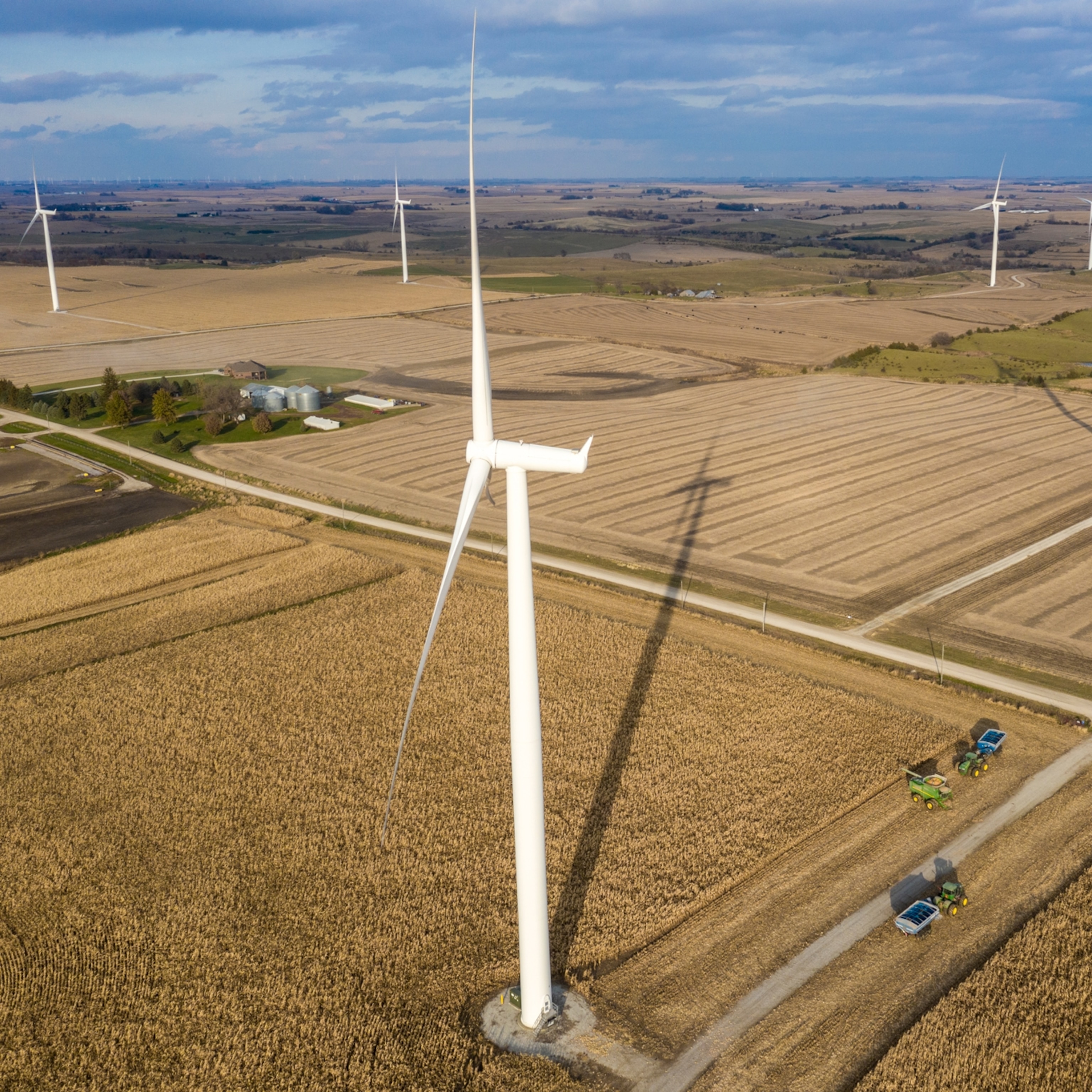
How the historic climate bill will dramatically reduce U.S. emissions

5 environmental victories from 2021 that offer hope
Solar: From home rooftops to utility-scale farms, solar power is reshaping energy markets around the world. In the decade from 2007 and 2017 the world's total installed energy capacity from photovoltaic panels increased a whopping 4,300 percent .
In addition to solar panels, which convert the sun's light to electricity, concentrating solar power (CSP) plants use mirrors to concentrate the sun's heat, deriving thermal energy instead. China, Japan, and the U.S. are leading the solar transformation, but solar still has a long way to go, accounting for around two percent of the total electricity generated in the U.S. in 2017. Solar thermal energy is also being used worldwide for hot water, heating, and cooling.
Biomass: Biomass energy includes biofuels such as ethanol and biodiesel , wood and wood waste, biogas from landfills, and municipal solid waste. Like solar power, biomass is a flexible energy source, able to fuel vehicles, heat buildings, and produce electricity. But biomass can raise thorny issues.
Critics of corn-based ethanol , for example, say it competes with the food market for corn and supports the same harmful agricultural practices that have led to toxic algae blooms and other environmental hazards. Similarly, debates have erupted over whether it's a good idea to ship wood pellets from U.S. forests over to Europe so that it can be burned for electricity. Meanwhile, scientists and companies are working on ways to more efficiently convert corn stover , wastewater sludge , and other biomass sources into energy, aiming to extract value from material that would otherwise go to waste.
Geothermal: Used for thousands of years in some countries for cooking and heating, geothermal energy is derived from the Earth’s internal heat . On a large scale, underground reservoirs of steam and hot water can be tapped through wells that can go a mile deep or more to generate electricity. On a smaller scale, some buildings have geothermal heat pumps that use temperature differences several feet below ground for heating and cooling. Unlike solar and wind energy, geothermal energy is always available, but it has side effects that need to be managed, such as the rotten egg smell that can accompany released hydrogen sulfide.
Ways to boost renewable energy
Cities, states, and federal governments around the world are instituting policies aimed at increasing renewable energy. At least 29 U.S. states have set renewable portfolio standards —policies that mandate a certain percentage of energy from renewable sources, More than 100 cities worldwide now boast at least 70 percent renewable energy, and still others are making commitments to reach 100 percent . Other policies that could encourage renewable energy growth include carbon pricing, fuel economy standards, and building efficiency standards. Corporations are making a difference too, purchasing record amounts of renewable power in 2018.
Wonder whether your state could ever be powered by 100 percent renewables? No matter where you live, scientist Mark Jacobson believes it's possible. That vision is laid out here , and while his analysis is not without critics , it punctuates a reality with which the world must now reckon. Even without climate change, fossil fuels are a finite resource, and if we want our lease on the planet to be renewed, our energy will have to be renewable.
Related Topics
- SUSTAINABILITY
- RENEWABLE ENERGY
- GEOTHERMAL ENERGY
- SOLAR POWER
- HYDROELECTRIC POWER
- CLIMATE CHANGE

Activists fear a new threat to biodiversity—renewable energy
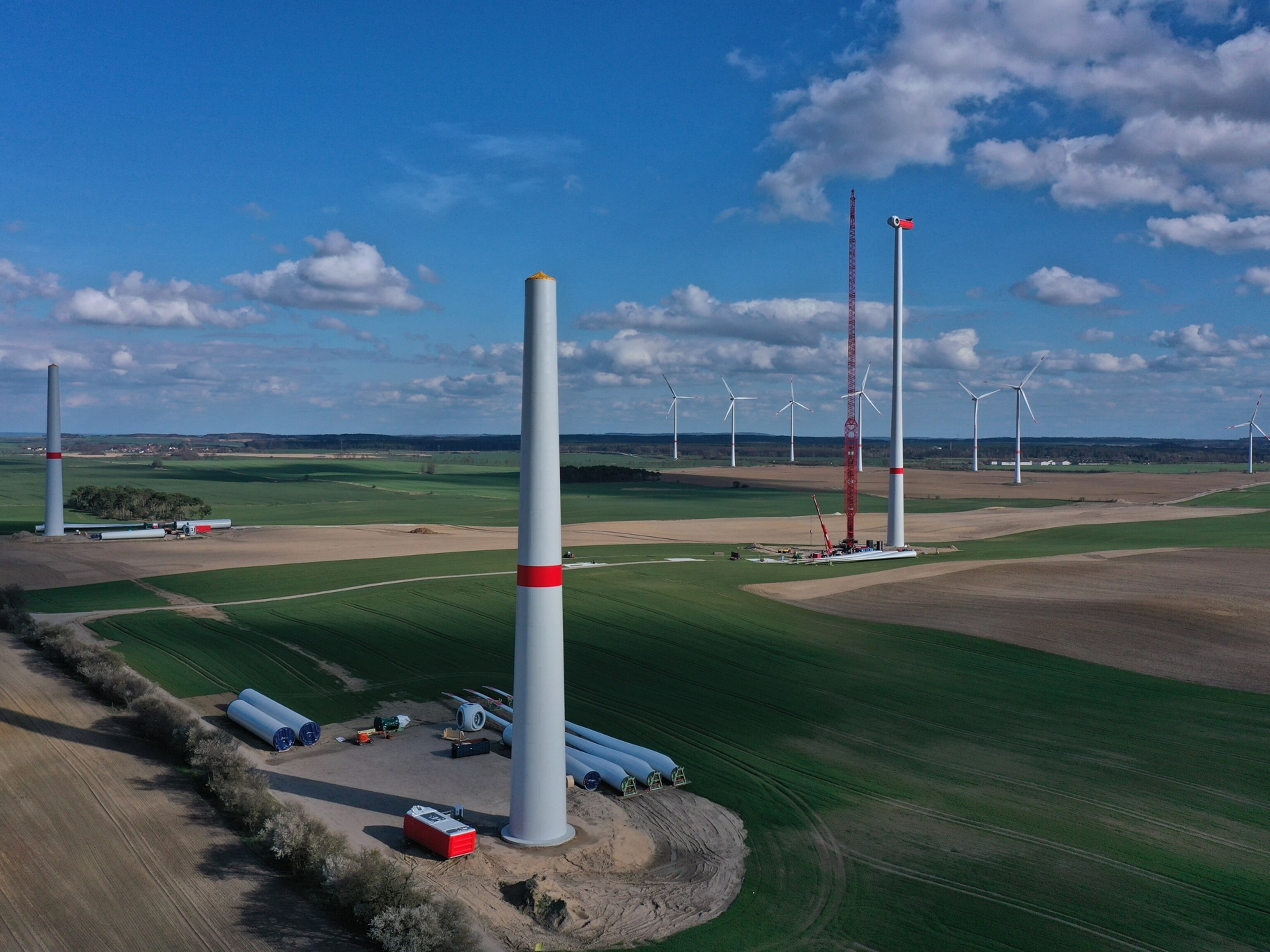
How the Ukraine war is accelerating Germany's renewable energy transition

We took the Great American Road Trip—in electric cars
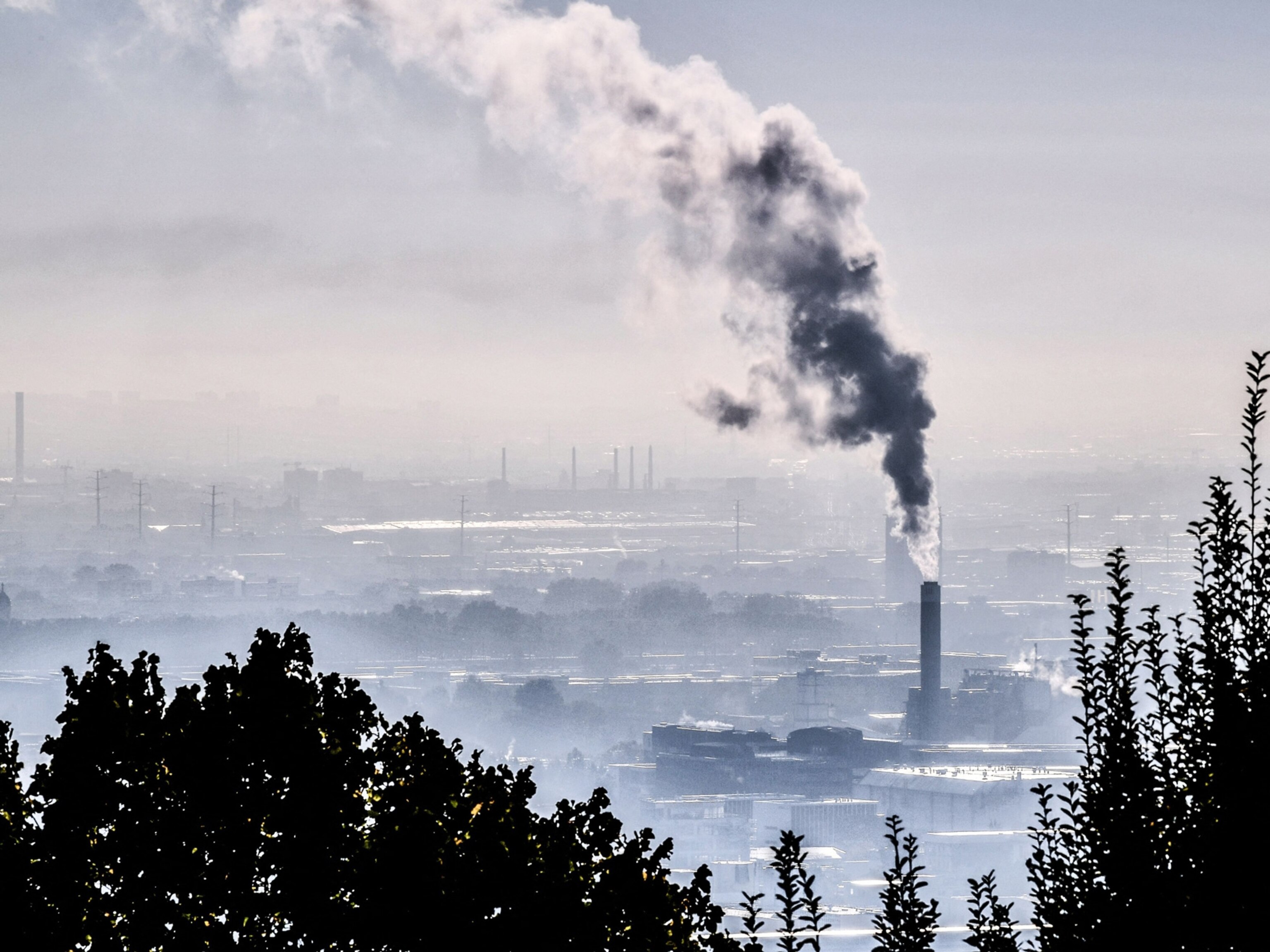
What’s at stake at COP26—the crucial global climate summit
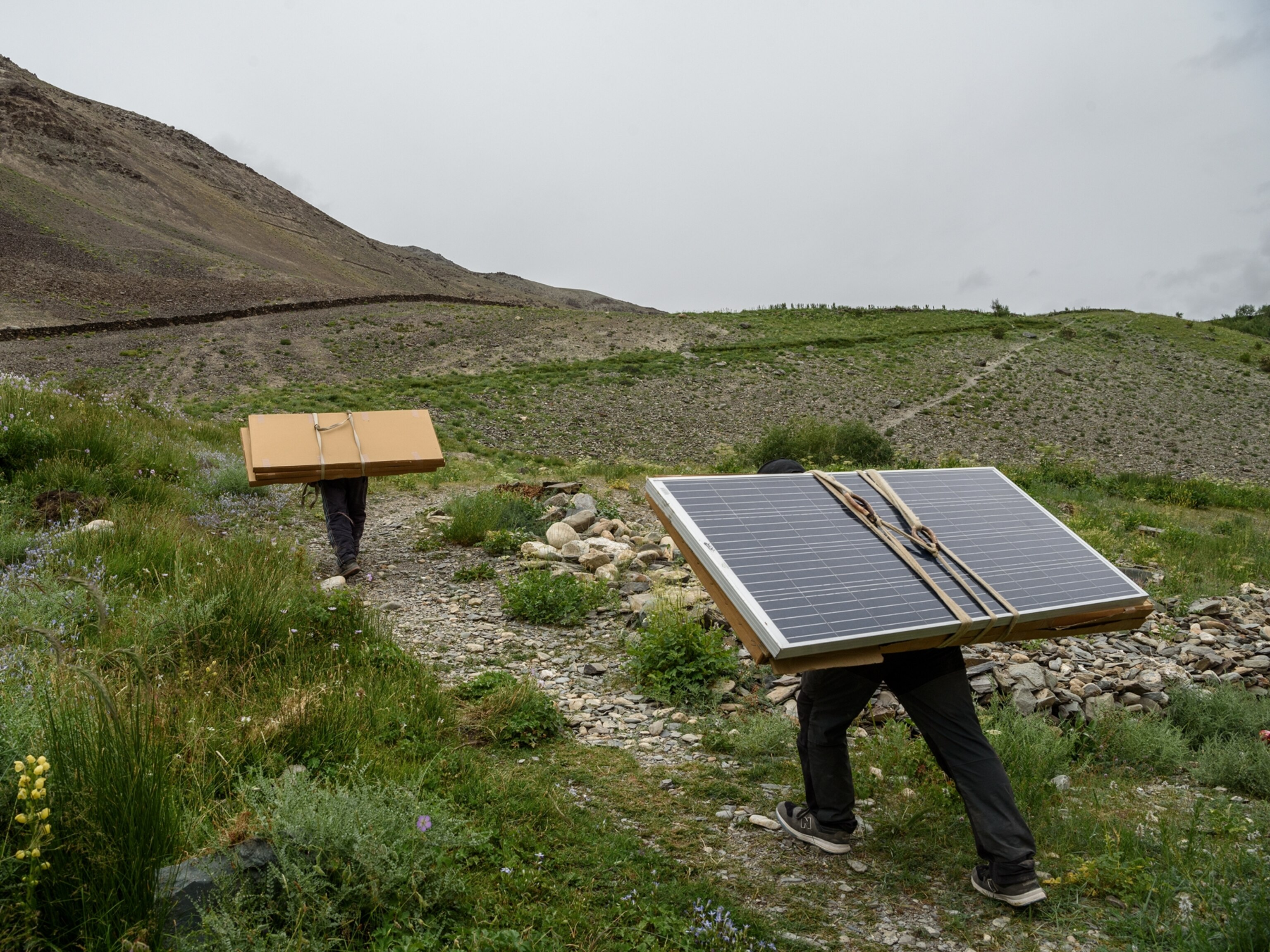
India bets its energy future on solar—in ways both small and big
- Perpetual Planet
- Environment
- History & Culture
- Paid Content
History & Culture
- Photography
- Terms of Use
- Privacy Policy
- Your US State Privacy Rights
- Children's Online Privacy Policy
- Interest-Based Ads
- About Nielsen Measurement
- Do Not Sell or Share My Personal Information
- Nat Geo Home
- Attend a Live Event
- Book a Trip
- Inspire Your Kids
- Shop Nat Geo
- Visit the D.C. Museum
- Learn About Our Impact
- Support Our Mission
- Advertise With Us
- Customer Service
- Renew Subscription
- Manage Your Subscription
- Work at Nat Geo
- Sign Up for Our Newsletters
- Contribute to Protect the Planet
Copyright © 1996-2015 National Geographic Society Copyright © 2015-2024 National Geographic Partners, LLC. All rights reserved
.png)
This Is the Future: Essay on Renewable Energy

Today the world population depends on nonrenewable energy resources. With the constantly growing demand for energy, natural gas, coal, and oil get used up and cannot replenish themselves.
Aside from limited supply, heavy reliance on fossil fuels causes planetary-scale damage. Sea levels are rising. Heat-trapping carbon dioxide increased the warming effect by 45% from 1990 to 2019. The only way to tackle the crisis is to start the transition to renewable energy now.
What is renewable energy? It is energy that comes from replenishable natural resources like sunlight, wind, thermal energy, moving water, and organic materials. Renewable resources do not run out. They are cost-efficient and renew faster than they are consumed. How does renewable energy save money? It creates new jobs, supports economic growth, and decreases inequitable fossil fuel subsidies.
At the current rates of production, some fossil fuels will not even last another century. This is why the future depends on reliable and eco-friendly resources. This renewable energy essay examines the types and benefits of renewable energy and its role in creating a sustainable future.
Top 5 Types of Renewable Energy: The Apollo Alliance Rankings
There are many natural resources that can provide people with clean energy. To make a list of the five most booming types of renewable energy on the market today, this energy essay uses data gathered by the Apollo Alliance. It is a project that aims to revolutionize the energy sector of the US with a focus on clean energy.
The Apollo Alliance unites businesses, community leaders, and environmental experts to support the transition to more sustainable and efficient living. Their expert opinion helped to compile information about the most common and cost-competitive sources of renewable energy. However, if you want to get some more in-depth research, you can entrust it to an essay writer . Here’s a quick overview of renewable energy resources that have a huge potential to substitute fossil fuels.
Solar Renewable Energy
The most abundant and practically endless resource is solar energy. It can be turned into electricity by photovoltaic systems that convert radiant energy captured from sunlight. Solar farms could generate enough energy for thousands of homes.
An endless supply is the main benefit of solar energy. The rate at which the Earth receives it is 10,000 times greater than people can consume it, as a paper writer points out based on their analysis of research findings. It can substitute fossil fuels and deliver people electricity, hot water, cooling, heat, etc.
The upfront investment in solar systems is rather expensive. This is one of the primary limitations that prevent businesses and households from switching to this energy source at once. However, the conclusion of solar energy is still favorable. In the long run, it can significantly decrease energy costs. Besides, solar panels are gradually becoming more affordable to manufacture and adopt, even at an individual level.
Wind Renewable Energy
Another clean energy source is wind. Wind farms use the kinetic energy of wind flow to convert it into electricity. The Appolo Alliance notes that, unlike solar farms, they can’t be placed in any location. To stay cost-competitive, wind farms should operate in windy areas. Although not all countries have the right conditions to use them on a large scale, wind farms might be introduced for some energy diversity. The technical potential for it is still tremendous.
Wind energy is clean and safe for the environment. It does not pollute the atmosphere with any harmful products compared to nonrenewable energy resources.
The investment in wind energy is also economically wise. If you examine the cost of this energy resource in an essay on renewable resources, you’ll see that wind farms can deliver electricity at a price lower than nonrenewable resources. Besides, since wind isn’t limited, its cost won’t be influenced by the imbalance of supply and demand.
Geothermal Renewable Energy
Natural renewable resources are all around us, even beneath the ground. Geothermal energy can be produced from the thermal energy from the Earth’s interior. Sometimes heat reaches the surface naturally, for example, in the form of geysers. But it can also be used by geothermal power plants. The Earth’s heat gets captured and converted to steam that turns a turbine. As a result, we get geothermal energy.
This source provides a significant energy supply while having low emissions and no significant footprint on land. A factsheet and essay on renewable resources state that geothermal plants will increase electricity production from 17 billion kWh in 2020 to 49.8 billion kWh in 2050.
However, this method is not without limitations. While writing a renewable resources essay, consider that geothermal energy can be accessed only in certain regions. Geological hotspots are off-limits as they are vulnerable to earthquakes. Yet, the quantity of geothermal resources is likely to grow as technology advances.
Ocean Renewable Energy
The kinetic and thermal energy of the ocean is a robust resource. Ocean power systems rely on:
- Changes in sea level;
- Wave energy;
- Water surface temperatures;
- The energy released from seawater and freshwater mixing.
Ocean energy is more predictable compared to other resources. As estimated by EPRI, it has the potential to produce 2640 TWh/yr. However, an important point to consider in a renewable energy essay is that the kinetic energy of the ocean varies. Yet, since it is ruled by the moon’s gravity, the resource is plentiful and continues to be attractive for the energy industry.
Wave energy systems are still developing. The Apollo energy corporation explores many prototypes. It is looking for the most reliable and robust solution that can function in the harsh ocean environment.
Another limitation of ocean renewable energy is that it may cause disruptions to marine life. Although its emissions are minimal, the system requires large equipment to be installed in the ocean.
Biomass Renewable Energy
Organic materials like wood and charcoal have been used for heating and lighting for centuries. There are a lot more types of biomass: from trees, cereal straws, and grass to processed waste. All of them can produce bioenergy.
Biomass can be converted into energy through burning or using methane produced during the natural process of decomposition. In an essay on renewable sources of energy, the opponents of the method point out that biomass energy is associated with carbon dioxide emissions. Yet, the amount of released greenhouse gases is much lower compared to nonrenewable energy use.
While biomass is a reliable source of energy, it is only suitable for limited applications. If used too extensively, it might lead to disruptions in biodiversity, a negative impact on land use, and deforestation. Still, Apollo energy includes biomass resources that become waste and decompose quickly anyway. These are organic materials like sawdust, chips from sawmills, stems, nut shells, etc.
What Is the Apollo Alliance?
The Apollo Alliance is a coalition of business leaders, environmental organizations, labor unions, and foundations. They all unite their efforts in a single project to harness clean energy in new, innovative ways.
Why Apollo? Similarly to President John F. Kennedy’s Apollo Project, Apollo energy is a strong visionary initiative. It is a dare, a challenge. The alliance calls for the integrity of science, research, technology, and the public to revolutionize the energy industry.
The project has a profound message. Apollo energy solutions are not only about the environment or energy. They are about building a new economy. The alliance gives hope to building a secure future for Americans.
What is the mission of the Apollo Alliance?
- Achieve energy independence with efficient and limitless resources of renewable energy.
- Pioneer innovation in the energy sector.
- Build education campaigns and communication to inspire new perceptions of energy.
- Create new jobs.
- Reduce dependence on imported fossil fuels.
- Build healthier and happier communities.
The transformation of the industry will lead to planet-scale changes. The Apollo energy corporation can respond to the global environmental crisis and prevent climate change.
Apollo renewable energy also has the potential to become a catalyst for social change. With more affordable energy and new jobs in the industry, people can bridge the inequality divide and build stronger communities.
Why Renewable Energy Is Important for the Future
Renewable energy resources have an enormous potential to cover people’s energy needs on a global scale. Unlike fossil fuels, they are available in abundance and generate minimal to no emissions.
The burning of fossil fuels caused a lot of environmental problems—from carbon dioxide emissions to ocean acidification. Research this issue in more detail with academic assistance from essay writer online . You can use it to write an essay on renewable sources of energy to explain the importance of change and its global impact.
Despite all the damage people caused to the planet, there’s still hope to mitigate further repercussions. Every renewable energy essay adds to the existing body of knowledge we have today and advances research in the field. Here are the key advantages and disadvantages of alternative energy resources people should keep in mind.
Advantage of Green Energy
The use of renewable energy resources has a number of benefits for the climate, human well-being, and economy:
- Renewable energy resources have little to no greenhouse gas emissions. Even if we take into account the manufacturing and recycling of the technologies involved, their impact on the environment is significantly lower compared to fossil fuels.
- Renewable energy promotes self-sufficiency and reduces a country’s dependence on foreign fuel. According to a study, a 1% increase in the use of renewable energy increases economic growth by 0.21%. This gives socio-economic stability.
- Due to a lack of supply of fossil fuels and quick depletion of natural resources, prices for nonrenewable energy keep increasing. In contrast, green energy is limitless and can be produced locally. In the long run, this allows decreasing the cost of energy.
- Unlike fossil fuels, renewable energy doesn’t emit air pollutants. This positively influences health and quality of life.
- The emergence of green energy plants creates new jobs. Thus, Apollo energy solutions support the growth of local communities. By 2030, the transition to renewable energy is expected to generate 10.3 million new jobs.
- Renewable energy allows decentralization of the industry. Communities get their independent sources of energy that are more flexible in terms of distribution.
- Renewable energy supports equality. It has the potential to make energy more affordable to low-income countries and expand access to energy even in remote and less fortunate neighborhoods.
Disadvantages of Non-Conventional Energy Sources
No technology is perfect. Renewable energy resources have certain drawbacks too:
- The production of renewable energy depends on weather conditions. For example, wind farms could be effective only in certain locations where the weather conditions allow it. The weather also makes it so that renewable energy cannot be generated around the clock.
- The initial cost of renewable energy technology is expensive. Both manufacturing and installation require significant investment. This is another disadvantage of renewable resources. It makes them unaffordable to a lot of businesses and unavailable for widespread individual use. In addition, the return on investment might not be immediate.
- Renewable energy technology takes up a lot of space. It may affect life in the communities where these clean energy farms are installed. They may also cause disruptions to wildlife in the areas.
- One more limitation a renewable resources essay should consider is the current state of technology. While the potential of renewable energy resources is tremendous, the technology is still in its development phase. Therefore, renewable energy might not substitute fossil fuels overnight. There’s a need for more research, investment, and time to transition to renewable energy completely. Yet, some diversity of energy resources should be introduced as soon as possible.
- Renewable energy resources have limited emissions, but they are not entirely pollution-free. The manufacturing process of equipment is associated with greenhouse gas emissions while, for example, the lifespan of a wind turbine is only 20 years.
For high school seniors eyeing a future rich with innovative endeavors in renewable energy or other fields, it's crucial to seek financial support early on. Explore the top 10 scholarships for high school seniors to find the right fit that can propel you into a future where you can contribute to the renewable energy movement and beyond. Through such financial support, the road to making meaningful contributions to a sustainable future becomes a tangible reality.
Renewable energy unlocks the potential for humanity to have clean energy that is available in abundance. It leads us to economic growth, independence, and stability. With green energy, we can also reduce the impact of human activity on the environment and stop climate change before it’s too late.
So what’s the conclusion of renewable energy? Transitioning to renewable energy resources might be challenging and expensive. However, most experts agree that the advantages of green energy outweigh any drawbacks. Besides, since technology is continuously evolving, we’ll be able to overcome most limitations in no time.

Frequently asked questions
She was flawless! first time using a website like this, I've ordered article review and i totally adored it! grammar punctuation, content - everything was on point
This writer is my go to, because whenever I need someone who I can trust my task to - I hire Joy. She wrote almost every paper for me for the last 2 years
Term paper done up to a highest standard, no revisions, perfect communication. 10s across the board!!!!!!!
I send him instructions and that's it. my paper was done 10 hours later, no stupid questions, he nailed it.
Sometimes I wonder if Michael is secretly a professor because he literally knows everything. HE DID SO WELL THAT MY PROF SHOWED MY PAPER AS AN EXAMPLE. unbelievable, many thanks
You Might Also Like

New Posts to Your Inbox!
Stay in touch
If you're seeing this message, it means we're having trouble loading external resources on our website.
If you're behind a web filter, please make sure that the domains *.kastatic.org and *.kasandbox.org are unblocked.
To log in and use all the features of Khan Academy, please enable JavaScript in your browser.

AP®︎/College Environmental science
Course: ap®︎/college environmental science > unit 5.
- Renewable and nonrenewable energy resources
Renewable and nonrenewable energy sources
- Global energy use
- Intro to energy resources and consumption
- Nonrenewable energy sources are those that are consumed faster than they can be replaced. Nonrenewable energy sources include nuclear energy as well as fossil fuels such as coal, crude oil, and natural gas. These energy sources have a finite supply, and often emit harmful pollutants into the environment.
- Renewable energy sources are those that are naturally replenished on a relatively short timescale. Renewable energy sources include solar, wind, hydroelectric, and geothermal energy. They also include biomass and hydrogen fuels. These energy sources are sustainable and generate fewer greenhouse gas emissions than fossil fuels.
Want to join the conversation?
- Upvote Button navigates to signup page
- Downvote Button navigates to signup page
- Flag Button navigates to signup page

Search the United Nations
- What Is Climate Change
- Myth Busters
- Renewable Energy
- Finance & Justice
- Initiatives
- Sustainable Development Goals
- Paris Agreement
- Climate Ambition Summit 2023
- Climate Conferences
- Press Material
- Communications Tips
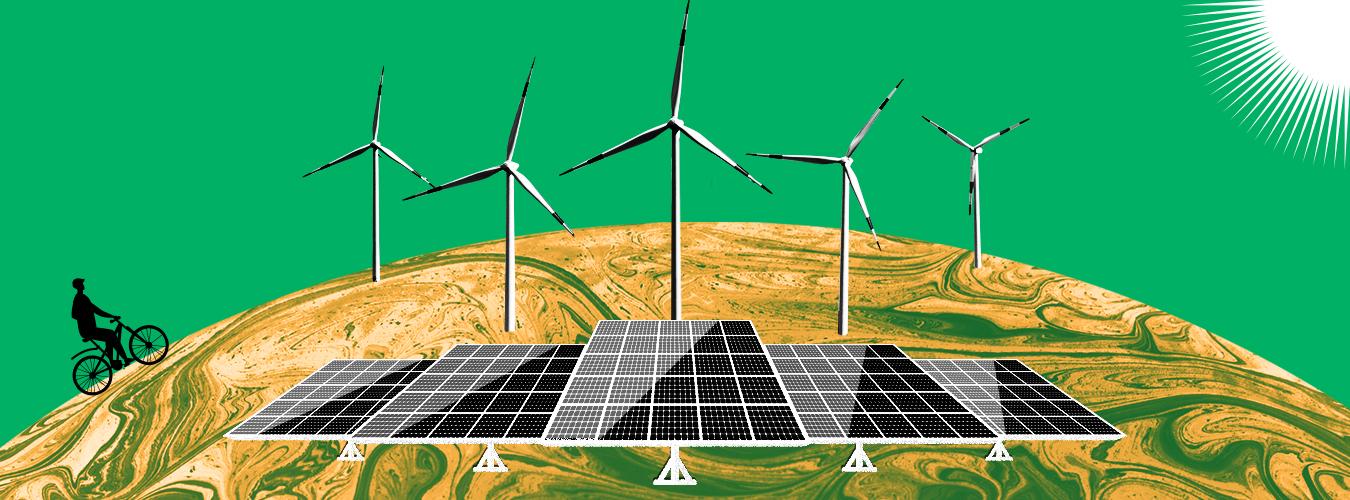
Renewable energy – powering a safer future
Energy is at the heart of the climate challenge – and key to the solution.
A large chunk of the greenhouse gases that blanket the Earth and trap the sun’s heat are generated through energy production, by burning fossil fuels to generate electricity and heat.
Fossil fuels, such as coal, oil and gas, are by far the largest contributor to global climate change , accounting for over 75 percent of global greenhouse gas emissions and nearly 90 percent of all carbon dioxide emissions.
The science is clear: to avoid the worst impacts of climate change, emissions need to be reduced by almost half by 2030 and reach net-zero by 2050.
To achieve this, we need to end our reliance on fossil fuels and invest in alternative sources of energy that are clean, accessible, affordable, sustainable, and reliable.
Renewable energy sources – which are available in abundance all around us, provided by the sun, wind, water, waste, and heat from the Earth – are replenished by nature and emit little to no greenhouse gases or pollutants into the air.
Fossil fuels still account for more than 80 percent of global energy production , but cleaner sources of energy are gaining ground. About 29 percent of electricity currently comes from renewable sources.
Here are five reasons why accelerating the transition to clean energy is the pathway to a healthy, livable planet today and for generations to come.
1. Renewable energy sources are all around us
About 80 percent of the global population lives in countries that are net-importers of fossil fuels -- that’s about 6 billion people who are dependent on fossil fuels from other countries, which makes them vulnerable to geopolitical shocks and crises.
In contrast, renewable energy sources are available in all countries, and their potential is yet to be fully harnessed. The International Renewable Energy Agency (IRENA) estimates that 90 percent of the world’s electricity can and should come from renewable energy by 2050.
Renewables offer a way out of import dependency, allowing countries to diversify their economies and protect them from the unpredictable price swings of fossil fuels, while driving inclusive economic growth, new jobs, and poverty alleviation.
2. Renewable energy is cheaper
Renewable energy actually is the cheapest power option in most parts of the world today. Prices for renewable energy technologies are dropping rapidly. The cost of electricity from solar power fell by 85 percent between 2010 and 2020. Costs of onshore and offshore wind energy fell by 56 percent and 48 percent respectively.
Falling prices make renewable energy more attractive all around – including to low- and middle-income countries, where most of the additional demand for new electricity will come from. With falling costs, there is a real opportunity for much of the new power supply over the coming years to be provided by low-carbon sources.
Cheap electricity from renewable sources could provide 65 percent of the world’s total electricity supply by 2030. It could decarbonize 90 percent of the power sector by 2050, massively cutting carbon emissions and helping to mitigate climate change.
Although solar and wind power costs are expected to remain higher in 2022 and 2023 then pre-pandemic levels due to general elevated commodity and freight prices, their competitiveness actually improves due to much sharper increases in gas and coal prices, says the International Energy Agency (IEA).
3. Renewable energy is healthier
According to the World Health Organization (WHO), about 99 percent of people in the world breathe air that exceeds air quality limits and threatens their health, and more than 13 million deaths around the world each year are due to avoidable environmental causes, including air pollution.
The unhealthy levels of fine particulate matter and nitrogen dioxide originate mainly from the burning of fossil fuels. In 2018, air pollution from fossil fuels caused $2.9 trillion in health and economic costs , about $8 billion a day.
Switching to clean sources of energy, such as wind and solar, thus helps address not only climate change but also air pollution and health.
4. Renewable energy creates jobs
Every dollar of investment in renewables creates three times more jobs than in the fossil fuel industry. The IEA estimates that the transition towards net-zero emissions will lead to an overall increase in energy sector jobs : while about 5 million jobs in fossil fuel production could be lost by 2030, an estimated 14 million new jobs would be created in clean energy, resulting in a net gain of 9 million jobs.
In addition, energy-related industries would require a further 16 million workers, for instance to take on new roles in manufacturing of electric vehicles and hyper-efficient appliances or in innovative technologies such as hydrogen. This means that a total of more than 30 million jobs could be created in clean energy, efficiency, and low-emissions technologies by 2030.
Ensuring a just transition , placing the needs and rights of people at the heart of the energy transition, will be paramount to make sure no one is left behind.
5. Renewable energy makes economic sense
About $7 trillion was spent on subsidizing the fossil fuel industry in 2022, including through explicit subsidies, tax breaks, and health and environmental damages that were not priced into the cost of fossil fuels.
In comparison, about $4 trillion a year needs to be invested in renewable energy until 2030 – including investments in technology and infrastructure – to allow us to reach net-zero emissions by 2050.
The upfront cost can be daunting for many countries with limited resources, and many will need financial and technical support to make the transition. But investments in renewable energy will pay off. The reduction of pollution and climate impacts alone could save the world up to $4.2 trillion per year by 2030.
Moreover, efficient, reliable renewable technologies can create a system less prone to market shocks and improve resilience and energy security by diversifying power supply options.
Learn more about how many communities and countries are realizing the economic, societal, and environmental benefits of renewable energy.
Will developing countries benefit from the renewables boom? Learn more here .
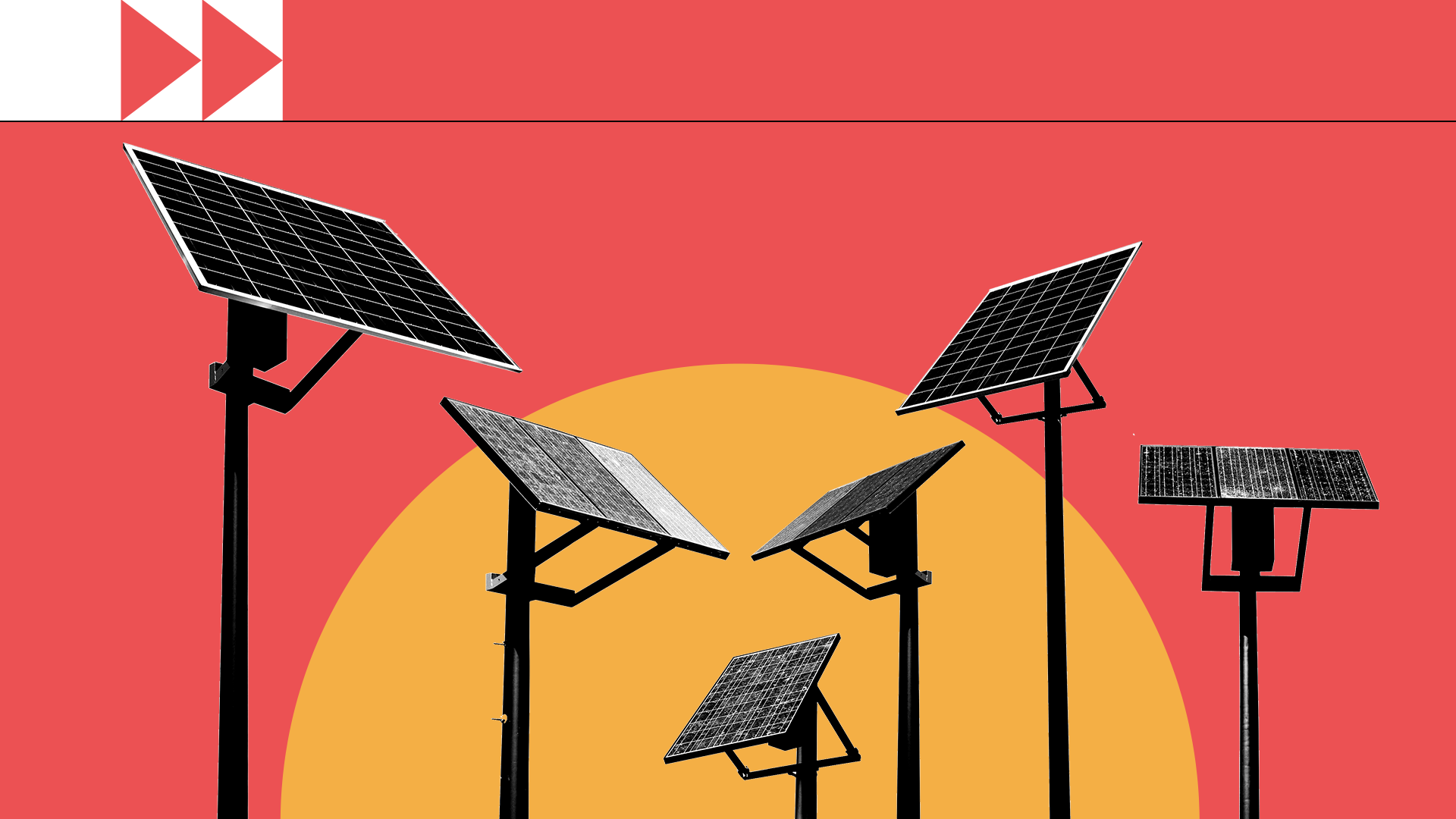
What is renewable energy?
Derived from natural resources that are abundant and continuously replenished, renewable energy is key to a safer, cleaner, and sustainable world. Explore common sources of renewable energy here.
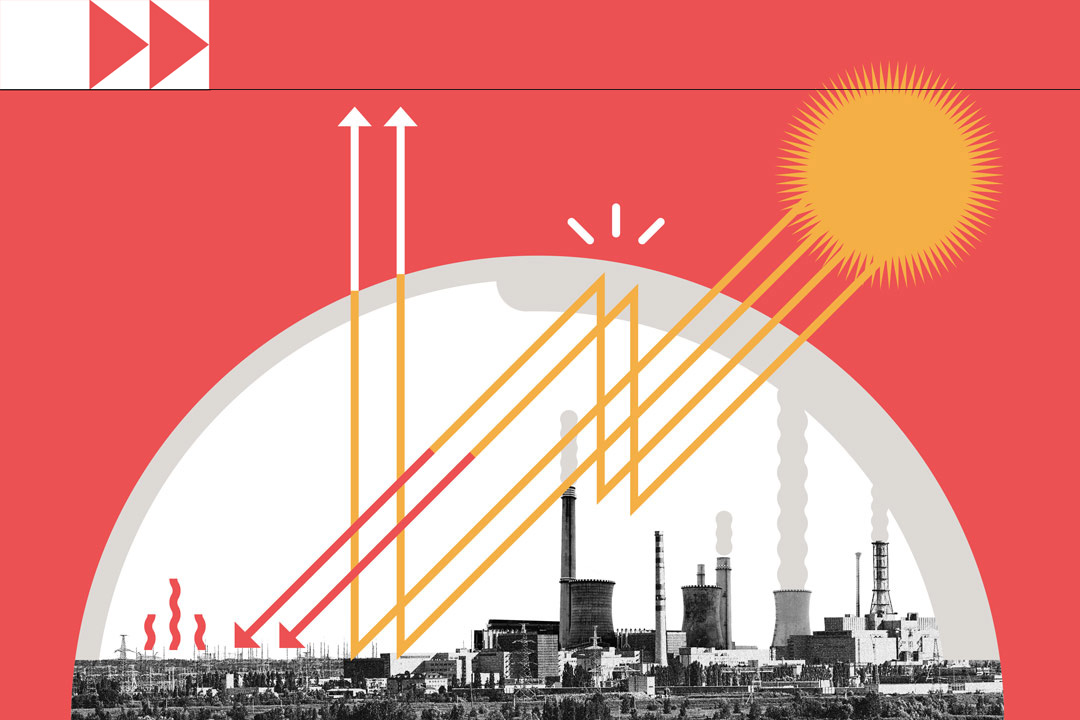
Why invest in renewable energy?
Learn more about the differences between fossil fuels and renewables, the benefits of renewable energy, and how we can act now.

Five ways to jump-start the renewable energy transition now
UN Secretary-General outlines five critical actions the world needs to prioritize now to speed up the global shift to renewable energy.

What is net zero? Why is it important? Our net-zero page explains why we need steep emissions cuts now and what efforts are underway.

- What is climate change?
Our climate 101 offers a quick take on the how and why of climate change. Read more.

How will the world foot the bill? We explain the issues and the value of financing climate action.

Climate issues
Learn more about how climate change impacts are felt across different sectors and ecosystems.
It’s time to stop burning our planet, and start investing in the abundant renewable energy all around us." ANTÓNIO GUTERRES , United Nations Secretary-General

Facts and figures
- Causes and effects
- Myth busters
Cutting emissions
- Explaining net zero
- High-level expert group on net zero
- Checklists for credibility of net-zero pledges
- Greenwashing
- What you can do
Clean energy
- Renewable energy – key to a safer future
- What is renewable energy
- Five ways to speed up the energy transition
- Why invest in renewable energy
- Clean energy stories
- A just transition
Adapting to climate change
- Climate adaptation
- Early warnings for all
- Youth voices
Financing climate action
- Finance and justice
- Loss and damage
- $100 billion commitment
- Why finance climate action
- Biodiversity
- Human Security
International cooperation
- What are Nationally Determined Contributions
- Acceleration Agenda
- Climate Ambition Summit
- Climate conferences (COPs)
- Youth Advisory Group
- Action initiatives
- Secretary-General’s speeches
- Press material
- Fact sheets
- Communications tips

- Wind Energy Technologies Office
- Wind Energy Career Map
- Key Activities in Wind Energy
- WETO Budget
- WETO Organization & Contacts
- Atmosphere to Electrons
- Distributed Wind
- Environmental Impacts & Siting
- Next-Generation Wind Technology
- Demonstration
- Floating Offshore Wind Shot
- Market Acceleration
- R&D Consortium
- Renewable Systems Integration
- Resource Assessment & Characterization
- Testing & Certification
- Drivetrains
- Infrastructure & Logistics
- Wind Turbine Radar Interference
- Wind Turbine Sustainability
- Workforce Development & Education
- History of Wind Energy
- How Distributed Wind Works
- How Wind Turbines Work
- WINDExchange
- Small Wind Systems FAQs
- WETO Peer Reviews
- Wind Energy FAQs
- Wind Energy Market Reports
- Wind Energy Projects Map
- Related Opportunities
- Wind Energy Technologies Office Updates
- Wind R&D Newsletter
Wind energy offers many advantages, which explains why it's one of the fastest-growing energy sources in the world. To further expand wind energy’s capabilities and community benefits, researchers are working to address technical and socio-economic challenges in support of a decarbonized electricity future.
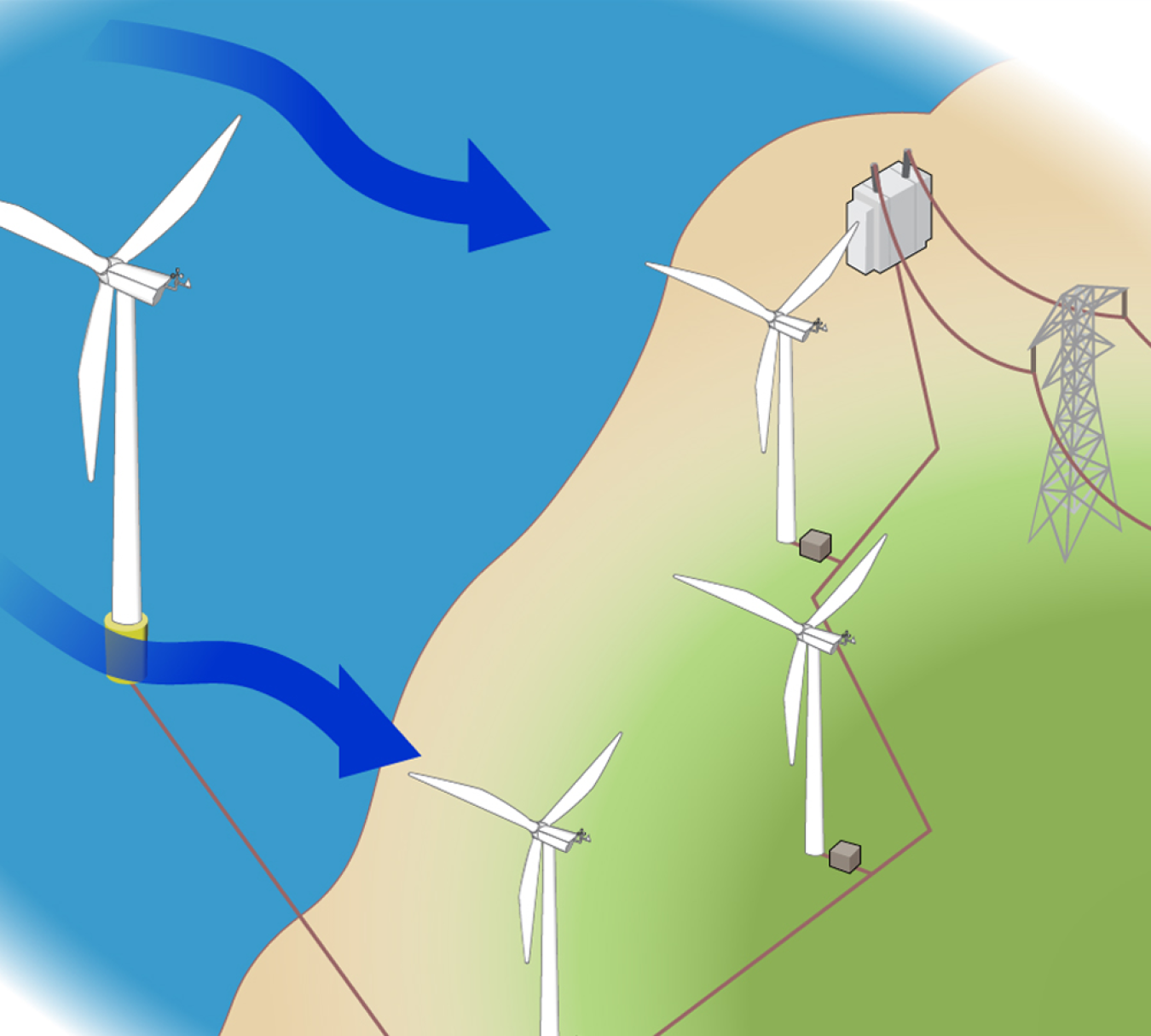
Learn more about ongoing research to take advantage of these benefits and tackle wind energy challenges.
Advantages of Wind Power
- Wind power creates good-paying jobs. There are over 125,000 people working in the U.S. wind industry across all 50 states, and that number continues to grow. According to the U.S. Bureau of Labor Statistics , wind turbine service technicians are the fastest growing U.S. job of the decade. Offering career opportunities ranging from blade fabricator to asset manager, the wind industry has the potential to support hundreds of thousands of more jobs by 2050.
- Wind power is a domestic resource that enables U.S. economic growth. In 2022, wind turbines operating in all 50 states generated more than 10% of the net total of the country’s energy . That same year, investments in new wind projects added $20 billion to the U.S. economy.
- Wind power is a clean and renewable energy source. Wind turbines harness energy from the wind using mechanical power to spin a generator and create electricity. Not only is wind an abundant and inexhaustible resource, but it also provides electricity without burning any fuel or polluting the air. Wind energy in the United States helps avoid 336 million metric tons of carbon dioxide emissions annually —equivalent to the emissions from 73 million cars.
- Wind power benefits local communities. Wind projects deliver an estimated $2 billion in state and local tax payments and land-lease payments each year. Communities that develop wind energy can use the extra revenue to put towards school budgets, reduce the tax burden on homeowners, and address local infrastructure projects.
- Wind power is cost-effective. Land-based, utility-scale wind turbines provide one of the lowest-priced energy sources available today. Furthermore, wind energy’s cost competitiveness continues to improve with advances in the science and technology of wind energy.
- Wind turbines work in different settings. Wind energy generation fits well in agricultural and multi-use working landscapes. Wind energy is easily integrated in rural or remote areas, such as farms and ranches or coastal and island communities, where high-quality wind resources are often found.
Challenges of Wind Power
- Wind power must compete with other low-cost energy sources. When comparing the cost of energy associated with new power plants , wind and solar projects are now more economically competitive than gas, geothermal, coal, or nuclear facilities. However, wind projects may not be cost-competitive in some locations that are not windy enough. Next-generation technology , manufacturing improvements , and a better understanding of wind plant physics can help bring costs down even more.
- Ideal wind sites are often in remote locations. Installation challenges must be overcome to bring electricity from wind farms to urban areas, where it is needed to meet demand. Upgrading the nation’s transmission network to connect areas with abundant wind resources to population centers could significantly reduce the costs of expanding land-based wind energy. In addition, offshore wind energy transmission and grid interconnection capabilities are improving.
- Turbines produce noise and alter visual aesthetics. Wind farms have different impacts on the environment compared to conventional power plants, but similar concerns exist over both the noise produced by the turbine blades and the visual impacts on the landscape .
- Wind plants can impact local wildlife. Although wind projects rank lower than other energy developments in terms of wildlife impacts, research is still needed to minimize wind-wildlife interactions . Advancements in technologies, properly siting wind plants, and ongoing environmental research are working to reduce the impact of wind turbines on wildlife.
- Share full article
Advertisement
Supported by
Guest Essay
The Fantasy of Reviving Nuclear Energy

By Stephanie Cooke
Ms. Cooke is a former editor of Nuclear Intelligence Weekly and the author of “In Mortal Hands: A Cautionary History of the Nuclear Age.”
World leaders are not unaware of the nuclear industry’s long history of failing to deliver on its promises, or of its weakening vital signs. Yet many continue to act as if a “nuclear renaissance” could be around the corner even though nuclear energy’s share of global electricity generation has fallen by almost half from its high of roughly 17 percent in 1996.
In search of that revival, representatives from more than 30 countries gathered in Brussels in March at a nuclear summit hosted by the International Atomic Energy Agency and the Belgian government. Thirty-four nations, including the United States and China, agreed “to work to fully unlock the potential of nuclear energy,” including extending the lifetime of existing reactors, building new nuclear power plants and deploying advanced reactors.
Yet even as they did so, there was an acknowledgment of the difficulty of their undertaking. “Nuclear technology can play an important role in the clean energy transition,” Ursula von der Leyen, the president of the European Commission, told summit attendees. But she added that “the reality today, in most markets, is a reality of a slow but steady decline in market share” for nuclear power.
The numbers underscore that downturn. Solar and wind power together began outperforming nuclear power globally in 2021, and that trend continues as nuclear staggers along. Solar alone added more than 400 gigawatts of capacity worldwide last year, two-thirds more than the previous year. That’s more than the roughly 375 gigawatts of combined capacity of the world’s 415 nuclear reactors, which remained relatively unchanged last year. At the same time, investment in energy storage technology is rapidly accelerating. In 2023, BloombergNEF reported that investors for the first time put more money into stationary energy storage than they did into nuclear.
Still, the drumbeat for nuclear power has become pronounced. At the United Nations climate conference in Dubai in December, the Biden administration persuaded two dozen countries to pledge to triple their nuclear energy capacity by 2050. Those countries included allies of the United States with troubled nuclear programs, most notably France , Britain , Japan and South Korea , whose nuclear bureaucracies will be propped up by the declaration as well as the domestic nuclear industries they are trying to save.
“We are not making the argument to anybody that this is absolutely going to be a sweeping alternative to every other energy source,” John Kerry, the Biden administration climate envoy at the time, said. “But we know because the science and the reality of facts and evidence tell us that you can’t get to net zero 2050 without some nuclear.”
That view has gained traction with energy planners in Eastern Europe who see nuclear as a means of replacing coal, and several countries — including Canada, Sweden, Britain and France — are pushing to extend the operating lifetimes of existing nuclear plants or build new ones. Some see smaller or more “advanced” reactors as a means of providing electricity in remote areas or as a means of decarbonizing sectors such as heat, industry or transportation.
So far most of this remains in early stages, with only three nuclear reactors under construction in Western Europe, two in Britain and one in France, each more than a decade behind schedule. Of the approximately 54 other reactors under construction worldwide as of March, 23 are in China, seven are in India, and three are in Russia, according to the International Atomic Energy Agency. The total is less than a quarter of the 234 reactors under construction in the peak year of 1979, although 48 of those were later suspended or abandoned.
Even if you agree with Mr. Kerry’s argument, and many energy experts do not, pledging to triple nuclear capacity by 2050 is a little like promising to win the lottery. For the United States, it would mean adding an additional 200 gigawatts of nuclear operating capacity (almost double what the country has ever built) to the 100 gigawatts or so that now exists, generated by more than 90 commercial reactors that have been running an average of 42 years. Globally it would mean tripling the existing capacity built over the past 70 years in less than half that time in addition to replacing reactors that will shut down before 2050.
The Energy Department estimates the total cost of such an effort in the United States at roughly $700 billion. But David Schlissel , a director at the Institute for Energy Economics and Financial Analysis , has calculated that the two new reactors at the Vogtle plant in Georgia — the only new reactors built in the United States in a generation — on average, cost $21.2 million per megawatt in today’s dollars — which translates to $21.2 billion per gigawatt. Using that figure as a yardstick, the cost of building 200 gigawatts of new capacity would be far higher: at least $4 trillion, or $6 trillion if you count the additional cost of replacing existing reactors as they age out.
For much less money and in less time, the world can reduce greenhouse gas emissions through the use of renewables like solar, wind, hydropower and geothermal power, and by transmitting, storing and using electricity more efficiently. A recent analysis by the German Environment Agency examined multiple global climate scenarios in which Paris Climate Agreement targets are met, and it found that renewable energy “is the crucial and primary driver.”
The logic of this approach was attested to at the climate meeting in Dubai, where more than 120 countries signed a more realistic commitment to triple renewable energy capacity by 2030.
There’s a certain inevitability about the U.S. Energy Department’s latest push for more nuclear energy. The agency’s predecessor, the Atomic Energy Commission, brought us Atoms for Peace under Dwight Eisenhower in the 1950s in a bid to develop the “peaceful” side of the atom, hoping it would gain public acceptance of an expanding arsenal of nuclear weapons while supplying electricity “too cheap to meter.”
Fast forward 70 years and you hear a variation on the same theme. Most notably, Ernest Moniz, the energy secretary under President Barack Obama, argues that a vibrant commercial nuclear sector is necessary to sustain U.S. influence in nuclear weapons nonproliferation efforts and global strategic stability. As a policy driver, this argument might explain in part why the government continues to push nuclear power as a climate solution, despite its enormous cost and lengthy delivery time.
China and Russia are conspicuously absent from the list of signatories to the Dubai pledge to triple nuclear power, although China signed the declaration in Brussels. China’s nuclear program is growing faster than that of any other country, and Russia dominates the global export market for reactors with projects in countries new to commercial nuclear energy, such as Turkey, Egypt and Bangladesh, as well as Iran.
Pledges and declarations on a global stage allow world leaders a platform to be seen to be doing something to address climate change even if, as is the case with nuclear, they lack the financing and infrastructure to succeed. But their support most likely means that substantial sums of money — much of it from taxpayers and ratepayers — will be wasted on perpetuating the fantasy that nuclear energy will make a difference in a meaningful time frame to slow global warming.
The U.S. government is already poised to spend billions of dollars building new small modular and “advanced” reactors and keeping aging large ones running. But two such small reactor projects based on conventional technologies have already failed. Which raises the question: Will future projects based on far more complex technologies be more viable? Money for such projects — provided mainly under the Infrastructure Investment and Jobs Act and the Inflation Reduction Act — could be redirected in ways that do more for the climate and do it faster, particularly if planned new nuclear projects fail to materialize.
There is already enough potential generation capacity in the United States seeking access to the grid to come close to achieving President Biden’s 2035 goal of a zero-carbon electricity sector, and 95 percent of it is solar, battery storage and wind. But these projects face a hugely constrained transmission system, regulatory and financial roadblocks and entrenched utility interests, enough to prevent many of them from ever providing electricity, according to a report released last year by the Lawrence Berkeley National Laboratory.
Even so, existing transmission capacity can be doubled by retrofitting transmission lines with advanced conductors, which would offer at least a partial way out of the gridlock for renewables, in addition to storage, localized distribution and improved management of supply and demand.
What’s missing are leaders willing to buck their own powerful nuclear bureaucracies and choose paths that are far cheaper, less dangerous and quicker to deploy. Without them we are doomed to more promises and wasteful spending by nuclear proponents who have repeatedly shown that they can talk but can’t deliver.
Stephanie Cooke is a former editor of Nuclear Intelligence Weekly and the author of “In Mortal Hands: A Cautionary History of the Nuclear Age.”
The Times is committed to publishing a diversity of letters to the editor. We’d like to hear what you think about this or any of our articles. Here are some tips . And here’s our email: [email protected] .
Follow the New York Times Opinion section on Facebook , Instagram , TikTok , X and Threads .
How to Write an Argumentative Essay with Impact

When it comes to persuading others, legal professionals are masters. They use persuasive skills, like crafting compelling stories, to win cases in court. This shows how important it is to argue effectively, especially when the stakes are high. In our journey into argumentative essays, we'll learn how to structure our writing well, predict counterarguments, and tell a convincing story.
With help of our argumentative essay writer , you'll learn how to organize your ideas, support your arguments, and see examples that make it all clearer. Whether you're new to writing an argumentative essay or have some experience, come along to become better at arguing your point.
What Is an Argumentative Essay
Argumentative essays deal with topics that spark different opinions. Here, writers take a stand on an issue and back it up with evidence and reasons. The topic should be something people can have different views on. The goal isn't just to share an opinion but to persuade others to agree with the writer.
In these essays, writers use strong and convincing language, similar to when learning how to write persuasive essay . They try to make readers see their point of view. For example, in an essay about online education, the writer might say:
'Online education offers more flexibility and access compared to traditional classrooms.'
This statement sets up the essay to discuss reasons, evidence, and examples supporting this view. These essays rely on facts, stats, research, and examples to prove the writer's points.
If you find writing such essays daunting, don't worry. There are skilled writers who can help. If you feel like saying, ' Write essay for me !' let experienced writers handle it with their expertise.
Argumentative Essay Examples
Let's check out some example essays where convincing arguments, backed by facts and clear language, have made a big difference. These stories not only inspire us but also teach us valuable lessons on how to effectively sway opinions and create compelling narratives that resonate with others.
Argumentative Essay Example
Want to Spice Up Your Arguments with Our Sizzling Prose?
Order a paper on any argumentative essay prompts – because eloquence is the ultimate mic drop in the world of words.
Argumentative Essay Outline
Understanding how to structure an argumentative essay goes beyond having strong opinions. It involves creating a clear framework that helps both the writer and the reader follow a logical flow of ideas. In this part, we'll look closely at three different ways to outline an argumentative essay: the Aristotelian (Classic) method, the Toulmin model, and the Rogerian strategy. Each method has its own structure, giving writers various tools to craft convincing and well-organized arguments.
.webp)
Aristotelian (Classic)
The Aristotelian approach, also known as the Classic method, pays homage to the ancient wisdom of Aristotle's rhetorical principles. This argumentative essay structure is composed of three distinct movements: introduction, body, and conclusion.
Introduction :
- Initiate with a captivating hook to captivate the reader's attention.
- Offer background context to illuminate the significance of the topic at hand.
- Articulate a clear and concise thesis statement that unequivocally states your position.
- Deploy the power of logos (logical appeal) by presenting concrete evidence, factual information, and cogent reasoning.
- Establish ethos (ethical appeal) by integrating reputable sources to bolster your credibility and authority.
- Evoke pathos (emotional appeal) to resonate with the reader's emotions and forge a deeper connection.
Conclusion :
- Synthesize the main arguments and insights discussed throughout the essay.
- Reiterate the thesis to leave a lasting impression on the reader.
- Conclude with a poignant and thought-provoking closing statement that lingers in the reader's mind.
Crafted by philosopher Stephen Toulmin, this model zooms in on the pieces of an argument puzzle and how they fit together. Here's the breakdown, tailor-made by our team at dissertation writing services :
Claim : Clearly state your main argument or point.
Grounds : Back up your claim with evidence and support.
Warrant : Connect the dots between your claim and the evidence provided.
Backing : Give more backup for your reasoning.
Qualifier : Recognize any limitations or boundaries to your argument.
Rebuttal : Take on opposing views and arguments head-on.
Inspired by psychologist Carl Rogers, the Rogerian method for writing an argumentative essay prioritizes building bridges and fostering empathy.
- Set a neutral tone to encourage open-mindedness.
- Acknowledge the complexity of the topic to show understanding.
- Introduce the issue from various viewpoints to provide a broader understanding.
- Clearly state your stance while acknowledging opposing viewpoints to demonstrate fairness.
- Explore common ground and areas of agreement to foster understanding.
- Present your perspective with empathy, respecting differing opinions.
- Highlight shared objectives and potential areas for compromise to promote cooperation.
- Encourage ongoing dialogue to continue exploring solutions.
Argumentative Essay Structure
Understanding how to write an argumentative essay requires a structured approach that leads both writer and reader through a compelling narrative. Let's break it down into key parts: introduction, thesis statement, body paragraphs, and conclusion.
- Capture attention with a striking opener. 'In a world driven by environmental concerns, the debate over renewable energy sources becomes increasingly critical.'
- Offer a brief context to the topic. 'With the looming threat of climate change, society grapples with the urgent need for sustainable energy solutions.'
- Clearly state your stance. 'This essay argues that investing in solar energy is imperative for combating climate change and securing a greener future.'
Thesis Statement:
- Example: 'Investing in solar energy infrastructure is not only environmentally responsible but also economically advantageous.'
Body Paragraphs:
- Introduce the main idea. 'Solar energy presents a sustainable alternative to fossil fuels.'
- Provide supporting facts or examples. 'Research shows that solar power installations have steadily increased over the past decade, demonstrating growing global interest in renewable energy.'
- Explain the significance of the evidence. 'This trend indicates a shifting mindset towards clean energy, driven by concerns over climate change and dwindling fossil fuel reserves.'
- Recap key arguments. 'In summary, investing in solar energy offers a viable solution to mitigate climate change and reduce dependence on non-renewable resources.'
- Restate your thesis. 'Embracing solar energy not only addresses environmental challenges but also promotes sustainable economic development.'
- End with a compelling thought. 'By harnessing the power of the sun, we can pave the way for a brighter, cleaner future for generations to come.'
Building a Compelling Argumentative Essay Thesis
Crafting a strong thesis statement is essential for a persuasive argumentative essay. Let's dive into a guide that will help you create a thesis statement that grabs attention and sets the stage for your essay.
Ask a Provocative Question and Answer It
Start by igniting curiosity with a thought-provoking question that directly connects to your topic. Then, provide a clear and insightful response that not only sets the stage for your argument but also hints at the complexities and nuances surrounding the issue.
Example: 'Is the use of smartphones beneficial for children's development? This essay argues that while smartphones offer educational opportunities, excessive screen time may hinder social skills.'
Introduce Your Argument and Address Contrary Views
A good argumentative essay should begin with a bold assertion of your main claim. However, to truly enrich your position, it's important to delve deeper by acknowledging and addressing opposing perspectives. This not only showcases a nuanced understanding of the topic but also reinforces the validity of your argument.
Example: 'While many believe that technology improves productivity, it's crucial to consider its potential drawbacks. This essay asserts that while technology enhances efficiency, it can also lead to information overload and burnout.'
Outline Your Main Points for Clarity
Provide a brief overview of the key points you'll explore in your essay. This helps clarify your direction and prepares your reader for the arguments ahead.
Example: 'In examining the impact of technology on work-life balance, we'll explore the benefits of remote work, the challenges of constant connectivity, and strategies for achieving harmony between work and personal life.'
By adding these steps from our experts in research paper help to your thesis-building process, you establish a base that not only clearly expresses your standpoint but also captivates readers with interesting questions, challenges, and key points that will unfold in your essay.
How to Write an Argumentative Essay with Quick Steps
Let's break down each part of your writing process step by step. By embracing these steps, you'll sail through the challenges of argumentative writing, crafting a piece that not only shares your thoughts clearly but also grabs the attention and persuades your readers along the way.
.webp)
Generating Ideas
Before you start writing, take some time to brainstorm ideas. Research different viewpoints and gather information about your topic. Try techniques like freewriting or mind mapping to explore various angles and gather a range of perspectives. This phase is all about gathering a pool of ideas so that you can choose the strongest arguments to support your essay later on.
Getting Ready
Preparation is key before diving into the writing process. Organize your thoughts and argumentative essay topics into a coherent structure. Develop a focused thesis statement that not only communicates your main point but also sets the tone for your entire essay. This stage is crucial for refining your focus and ensuring that each part of your essay supports your central argument effectively.
Putting Pen to Paper
Now it's time to start writing! Maintain a logical progression in your essay as you draft your ideas. Begin with an engaging introduction that introduces your topic and presents your thesis statement. In the body paragraphs, explore each argument thoroughly, providing supporting evidence and examples. Don't forget to address potential counterarguments to demonstrate a well-rounded understanding of the topic. This step is all about fleshing out your ideas and constructing a compelling narrative.
Perfecting Your Work
Once you've finished drafting, it's time to refine your essay. Review your arguments to ensure they flow logically and contribute effectively to your thesis. Pay attention to the clarity of your language and the strength of your evidence. This stage allows you to fine-tune the persuasiveness of your essay, transforming it from a draft into a polished piece of writing.
Polishing the Final Product
Now it's time for the finishing touches! Meticulously proofread your essay to ensure it's polished and impactful. Check for grammar, punctuation, and sentence structure errors. Make sure your writing style remains consistent throughout and clarify any parts that may be unclear. In the conclusion, revisit your thesis statement and leave your reader with a thought-provoking statement that lingers in their mind. This attention to detail ensures that your argumentative essay not only captivates but also showcases your writing skills effectively.
Essential Argumentative Essay Tips
Our tips on writing an argumentative essay work just as effectively as they do for any other type of essay. So, if you're in need of additional guidance, here are some specific tips that can help you craft persuasive arguments:
Strengthen Your Case with Solid Facts
Ensure your argument is supported by reliable facts and evidence. Utilize research, data, and examples to reinforce your points. You can also use our essay writing help helping you ground your argument in verifiable information, demonstrate credibility and strengthen your position.
Example: Drawing from recent studies by leading environmental organizations, it's clear that deforestation has reached alarming levels, with devastating consequences for ecosystems worldwide. For instance, a study published in the Journal of Environmental Science found that deforestation contributes to biodiversity loss, soil erosion, and disruptions in the water cycle, highlighting the urgent need for conservation efforts.
Take Charge with Language
While learning how to write an argumentative essay, remember to choose your words carefully to convey your argument persuasively. Adopt a tone that is confident yet respectful, and craft your sentences to engage and convince your audience. The language you use can influence how your argument is perceived, so wield it skillfully to make a compelling case.
Example: Without a doubt, the urgency of addressing climate change demands immediate action and concerted efforts from policymakers and individuals alike. As evidenced by recent climate reports, the consequences of inaction are dire, with rising global temperatures leading to more frequent and severe weather events, loss of biodiversity, and threats to food security.
Employ Tools for Effective Writing
Similar to learning how to write an explanatory essay , structure your arguments logically, with a clear introduction, well-developed body paragraphs, and a concise conclusion. Use transition words to guide your reader smoothly through your argument. Incorporate rhetorical devices to add depth and resonance to your writing, making your arguments more impactful and memorable.
Example: Transitioning from the causes of environmental degradation to potential solutions, the essay navigates a range of approaches, each offering a unique perspective on balancing ecological preservation with human needs. For instance, implementing reforestation projects and promoting sustainable land management practices are crucial steps in mitigating the effects of deforestation and preserving natural habitats for future generations.
In this guide, we've covered the basics of crafting great argumentative essays. We've looked at everything from coming up with ideas to refining your final draft, sharing helpful strategies and tips along the way. With these insights into language, facts, and writing techniques, you're all set to create essays that really grab attention and persuade your readers. Consider this your starting point for smooth and confident argumentative writing.
Got Excellent Ideas?
Let's make your thoughts shine so bright they'll need sunglasses.
What’s a Good Starter for an Argumentative Essay?
Related articles.
.webp)
We've detected unusual activity from your computer network
To continue, please click the box below to let us know you're not a robot.
Why did this happen?
Please make sure your browser supports JavaScript and cookies and that you are not blocking them from loading. For more information you can review our Terms of Service and Cookie Policy .
For inquiries related to this message please contact our support team and provide the reference ID below.

IMAGES
VIDEO
COMMENTS
The first recorded use of renewable energy was harnessing wind power to drive ships over water about 7000 years ago (Darling). However, renewable energy has been around as long as Earth has existed: wind, sun, geothermal, biomass and many more. Clean energy sources can be harnessed to produce electricity, process heat, fuel and other chemicals ...
Renewable Energy Argumentative Essay. This essay sample was donated by a student to help the academic community. Papers provided by EduBirdie writers usually outdo students' samples. Recently, some people believe that nuclear, solar, wind and hydropower provide cheap and clean energy. The advantages of these sources of power far outweigh their ...
Essay on Renewable Energy. This essay sample was donated by a student to help the academic community. Papers provided by EduBirdie writers usually outdo students' samples. The world has been powered by carbon-based energy since the industrial revolution. It is what humans know as convenient, reliable, and cheap.
Top 10 Pro & Con Arguments. 1. Alternative Energy. Alternative energy consists of renewable energies (solar, wind, hydroelectric, geothermal, and biomass), plus nuclear energy. Renewable energy, according to the National Resources Defense Council (NRDC), is "often referred to as clean energy, [and] comes from natural sources or processes that ...
Renewable energy may seem like a daunting task, but the benefits to humanity could be incredible. Public uses of renewable energy range from transportation all the way to heating and cooling. Everything we use could become less explosive and less expensive. Cities with a high concentration of people could become safer and healthier places to live.
The wind, the sun, and Earth are sources of renewable energy . These energy sources naturally renew, or replenish themselves. Wind, sunlight, and the planet have energy that transforms in ways we can see and feel. We can see and feel evidence of the transfer of energy from the sun to Earth in the sunlight shining on the ground and the warmth we ...
renewable energy and the power system, thereby keeping my passion alive. I am blessed to have attended the last programming course of Dr. Paul Preckel, where my passion, dreams and goals took an unexpected turn. Not only his expertise in the field of energy but alsohis support for me
The United States is producing more energy from fossil fuels and has ticked up production of renewable sources such as wind and solar. A large majority of Americans (72%) say the United States is producing more energy than it did 20 years ago. Far smaller shares say the U.S. is producing the same level (17%) or less energy (10%) than it did 20 ...
Background Info. Vocabulary. In any discussion about climate change, renewable energy usually tops the list of changes the world can implement to stave off the worst effects of rising temperatures. That's because renewable energy sources, such as solar and wind, don't emit carbon dioxide and other greenhouse gases that contribute to global warming.
Hydropower: For centuries, people have harnessed the energy of river currents, using dams to control water flow. Hydropower is the world's biggest source of renewable energy by far, with China ...
The habit of renewable energy has turned out to be a seemingly more popular resource in the worlds pocket. The use of biofuels instead of fossil fuels greatly reduce pollution by cleaning the useable waste and creating a stable, lasting power source. NASA concluded in an analysis of a study by the National Oceanic and Atmospheric Administration ...
According to a study, a 1% increase in the use of renewable energy increases economic growth by 0.21%. This gives socio-economic stability. Due to a lack of supply of fossil fuels and quick depletion of natural resources, prices for nonrenewable energy keep increasing. In contrast, green energy is limitless and can be produced locally.
Renewable energy sources include solar, wind, hydroelectric, and geothermal energy. They also include biomass and hydrogen fuels. These energy sources are sustainable and generate fewer greenhouse gas emissions than fossil fuels. Renewable and nonrenewable energy sources. Clockwise from top left: a solar power station, a wind farm, a ...
Tidal power generators are the most predictable and affordable source of energy. For example, The Bay of Fundy in Canada has the world's highest tides, which reach speeds up to 17 kph generating 700 kilowatts of power compared to 600 kilowatts produced by wind turbines (Meyer 66). Therefore, the global implementation of renewable sources is a ...
The writers' enthusiasm for carbon-free electricity is laudable, but the fixation on nuclear power is misguided. To truly decarbonize the United States' economy, we need to fully use renewable ...
But investments in renewable energy will pay off. The reduction of pollution and climate impacts alone could save the world up to $4.2 trillion per year by 2030. Moreover, efficient, reliable ...
In contrast, renewable energy sources accounted for nearly 20 percent of global energy consumption at the beginning of the 21st century, largely from traditional uses of biomass such as wood for heating and cooking.By 2015 about 16 percent of the world's total electricity came from large hydroelectric power plants, whereas other types of renewable energy (such as solar, wind, and geothermal ...
Using more renewable energy can lower the prices of and demand for natural gas and coal by increasing competition and diversifying our energy supplies. And an increased reliance on renewable energy can help protect consumers when fossil fuel prices spike. Explainer. Renewables face major obstacles.
Argumentative Essay On Renewable Energy. The United States has used fossil fuels for electricity generation ever since the Industrial Revolution, which occurred nearly 250 years ago. It should not, therefore, be a surprise that in the recent past few years, new sources of generating clean and affordable energy have been found.
Wind energy in the United States helps avoid 336 million metric tons of carbon dioxide emissions annually. (link is external) —equivalent to the emissions from 73 million cars. Wind power benefits local communities. Wind projects deliver an estimated $2 billion. (link is external) in state and local tax payments and land-lease payments each year.
Words: 496. Page: 1. This essay sample was donated by a student to help the academic community. Papers provided by EduBirdie writers usually outdo students' samples. Cite this essay. Download. The most common and challenging issue that renewable energy is facing is the capital cost of erecting and installing wind and solar farms.
Guest Essay. The Fantasy of Reviving Nuclear Energy ... Even if you agree with Mr. Kerry's argument, and many energy experts do not, pledging to triple nuclear capacity by 2050 is a little like ...
Argumentative essays deal with topics that spark different opinions. Here, writers take a stand on an issue and back it up with evidence and reasons. ... 'In a world driven by environmental concerns, the debate over renewable energy sources becomes increasingly critical.' Offer a brief context to the topic. 'With the looming threat of climate ...
Built along a stretch of salt flats in southern India, the Tuticorin power plant epitomizes a quagmire for the world's fastest-growing major economy: how to provide reliable energy to 1.4 ...
Advantages and Disadvantages to the Use of Renewable Energy. Hydroelectric power is a very clean method of producing renewable energy since "it does not produce any greenhouse gases and is the cleanest of all the renewable energy sources" (National Geographic 2015, par. 4). Hydroelectric power uses the power of water to create electricity.
This paper proposes a multi-port medium-frequency power electronic transformer (PET) topology for integrating photovoltaic (PV) generation with battery storage (BS). Firstly, this proposed PET provides multiple ports for renewable energy grid generation, so that it can achieve multi-energy source management and energy complementary.
Behind wind comes geothermal energy, hydropower, nuclear energy, and then solar power. Out of all the known energy sources, nuclear energy has the highest capacity factor by far. Nuclear power plants are able to produce maximum power over 93% of the time on an annual basis. Next in line comes geothermal, followed by natural gas.